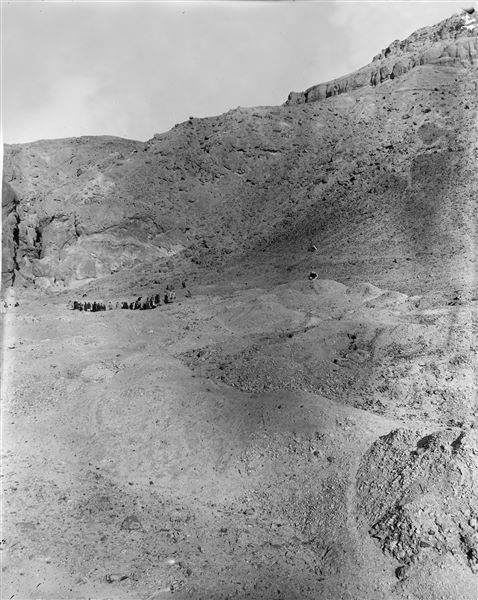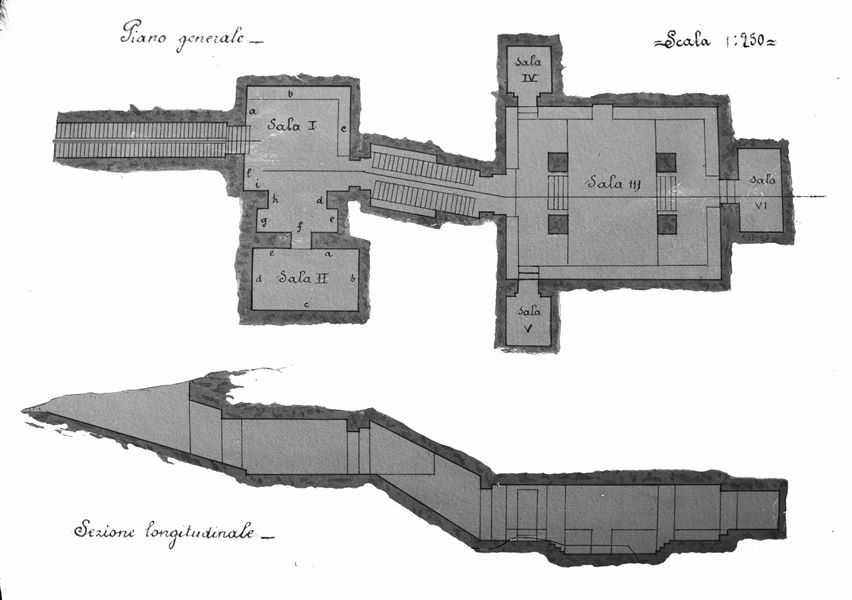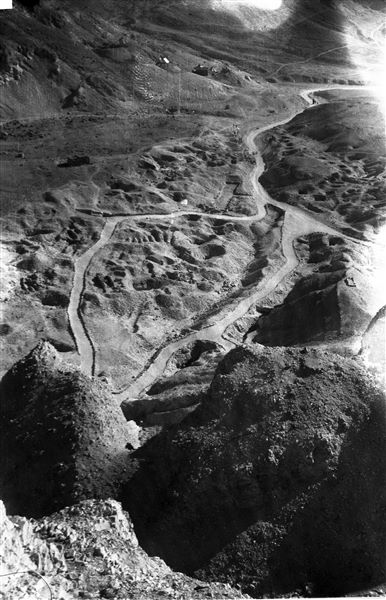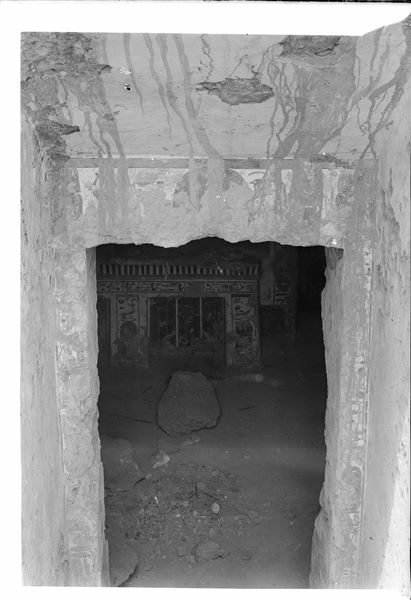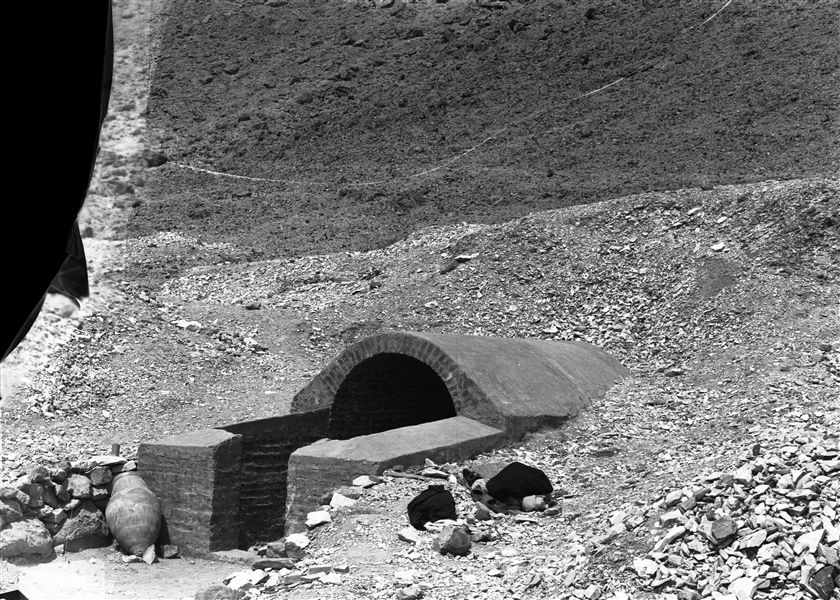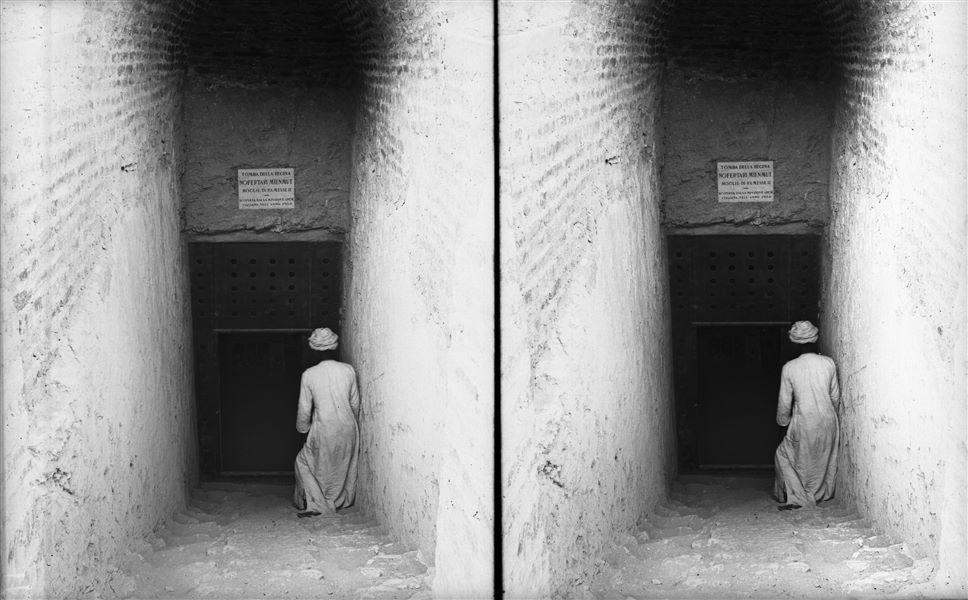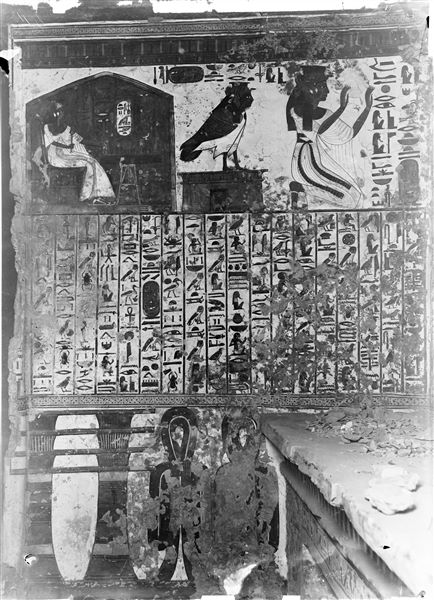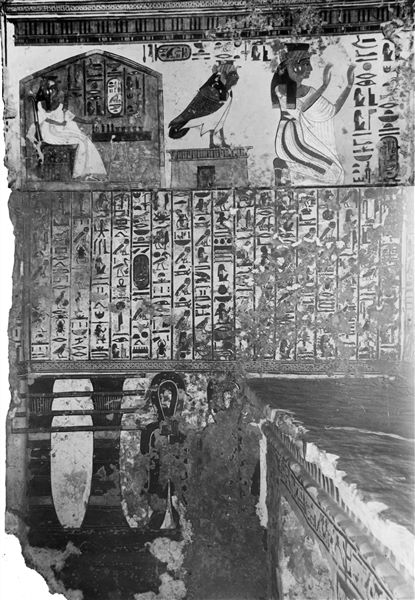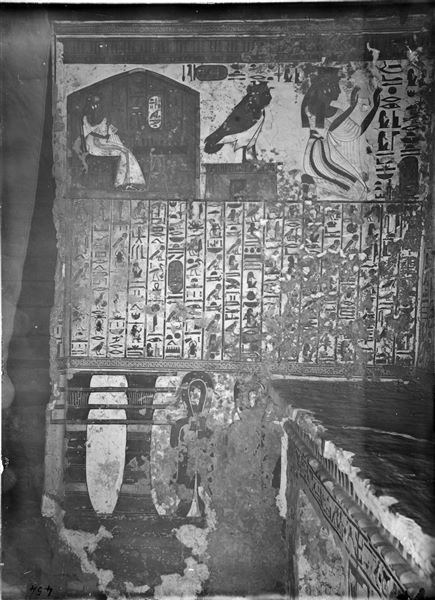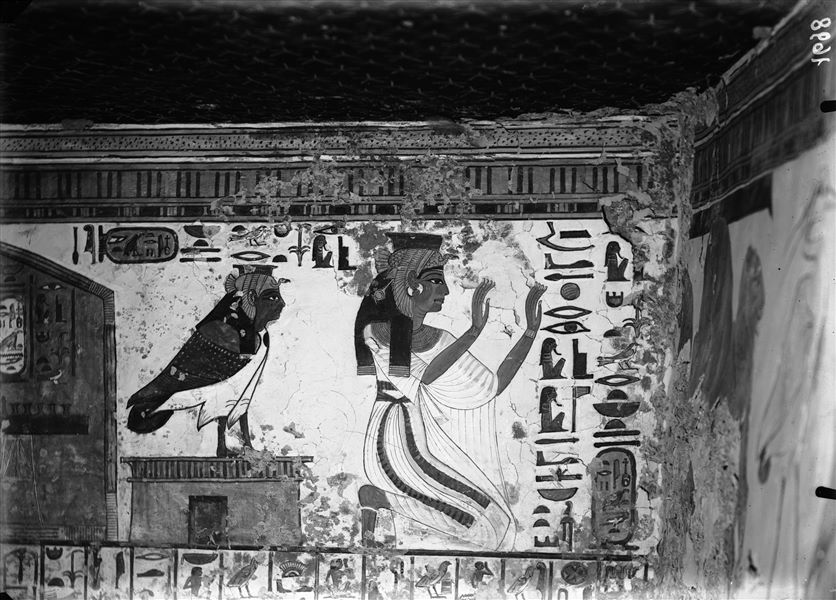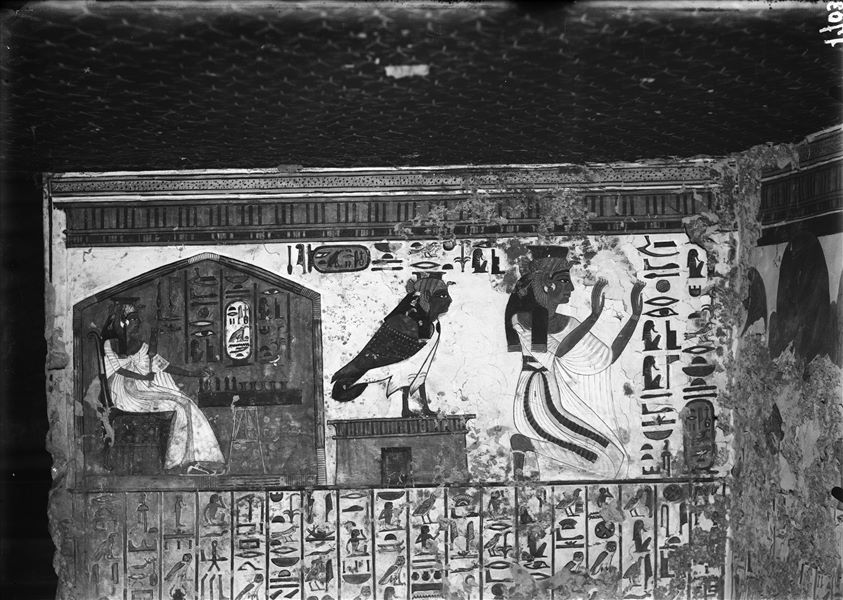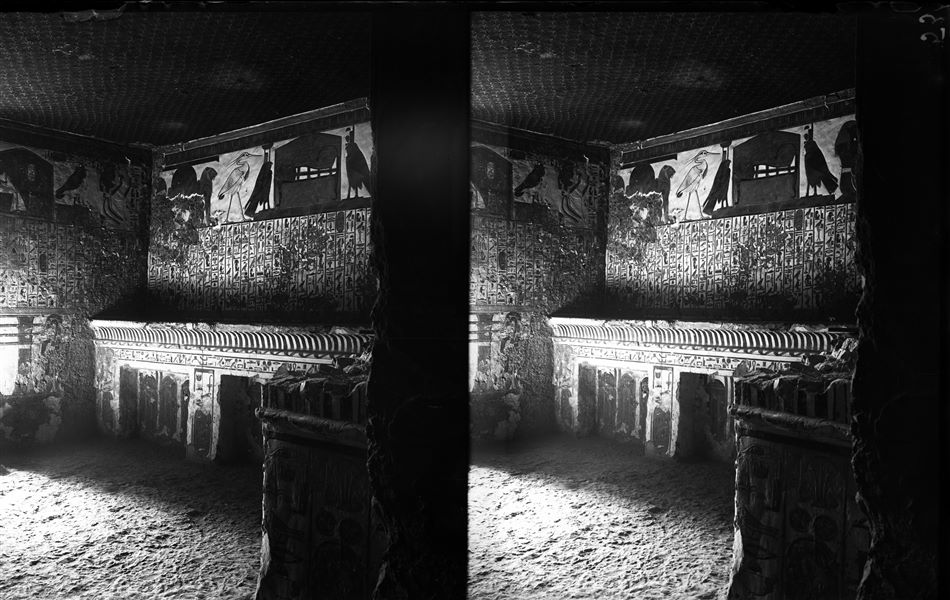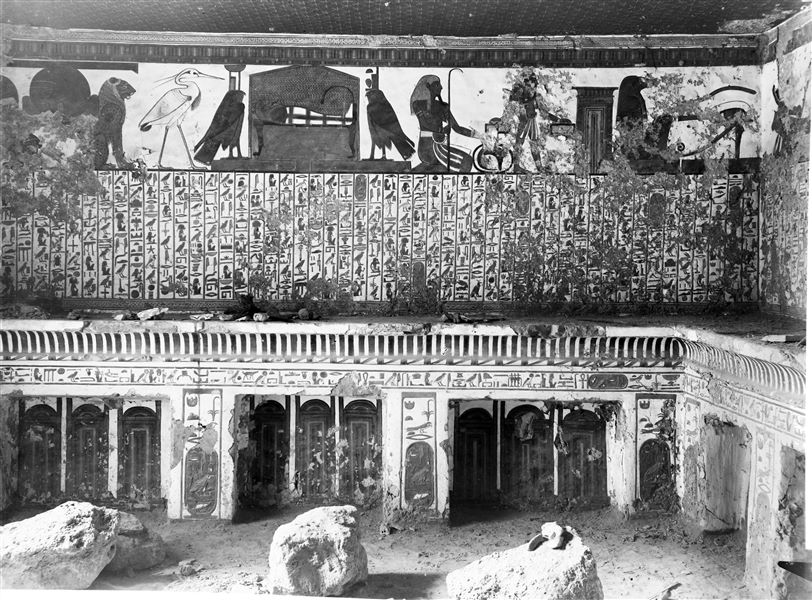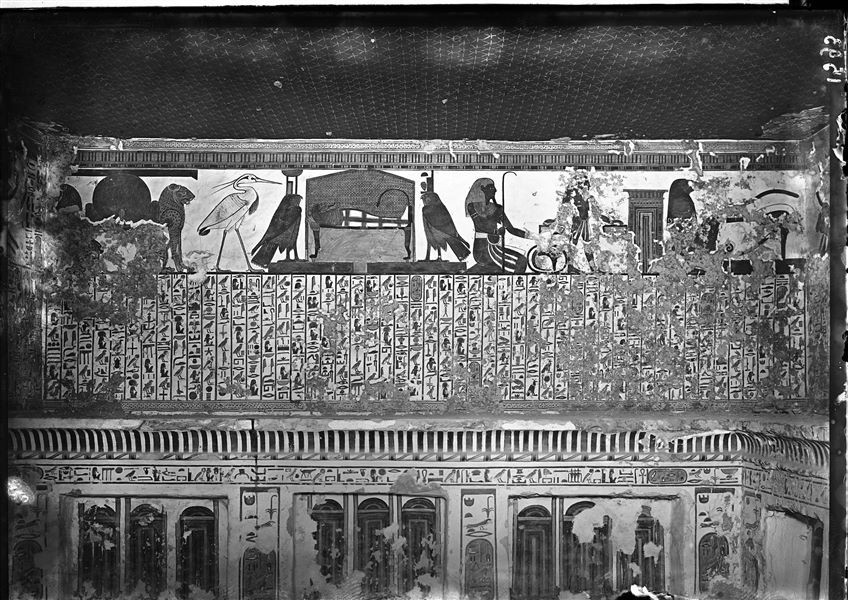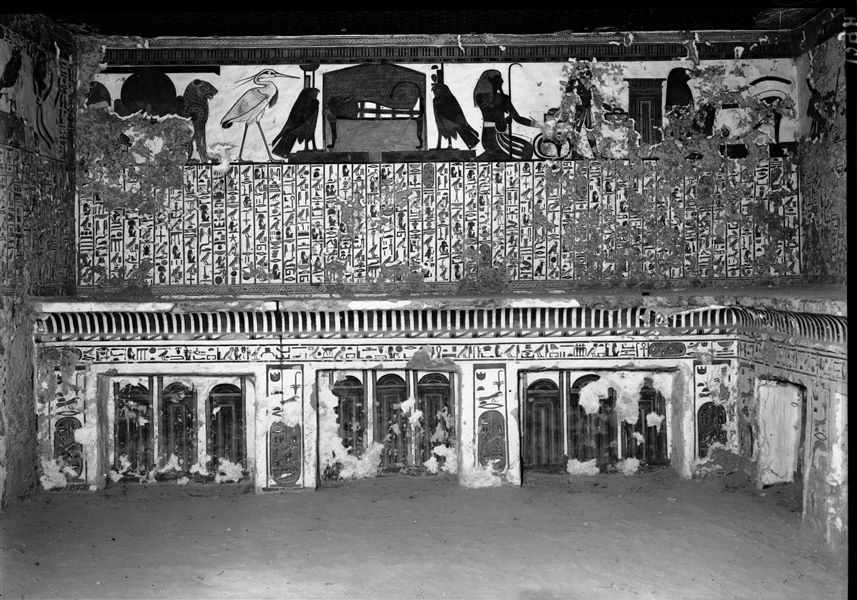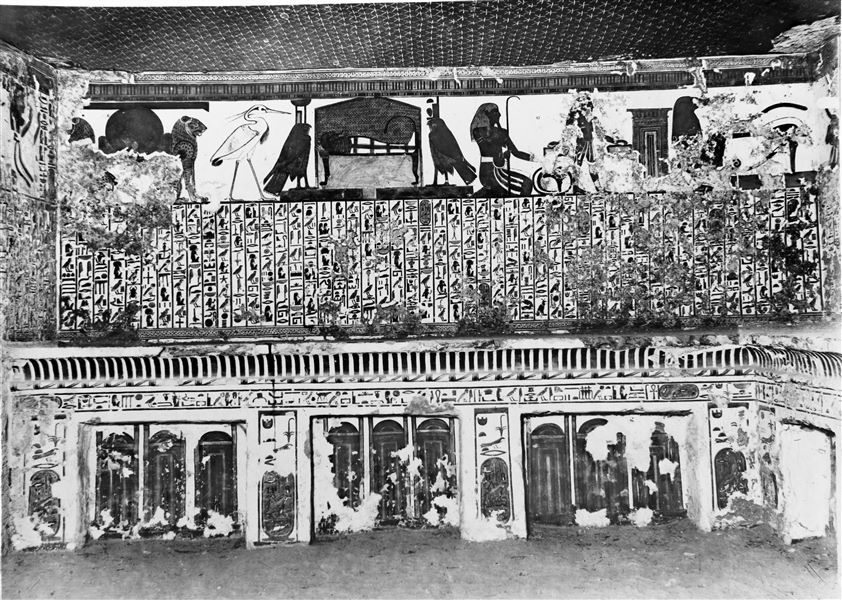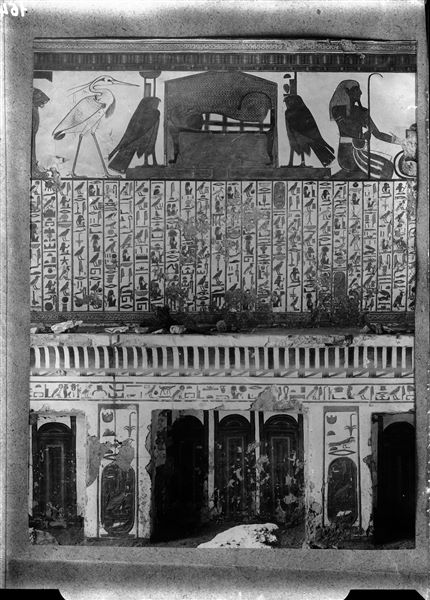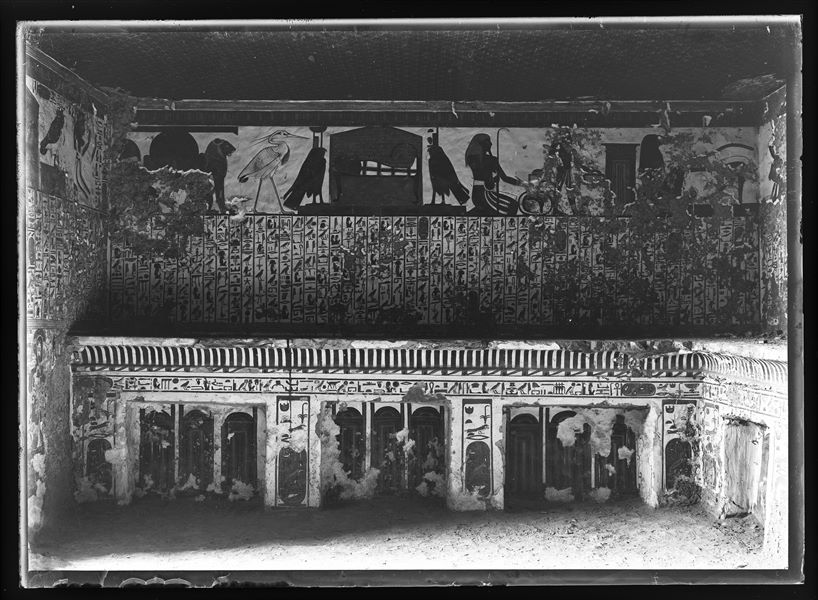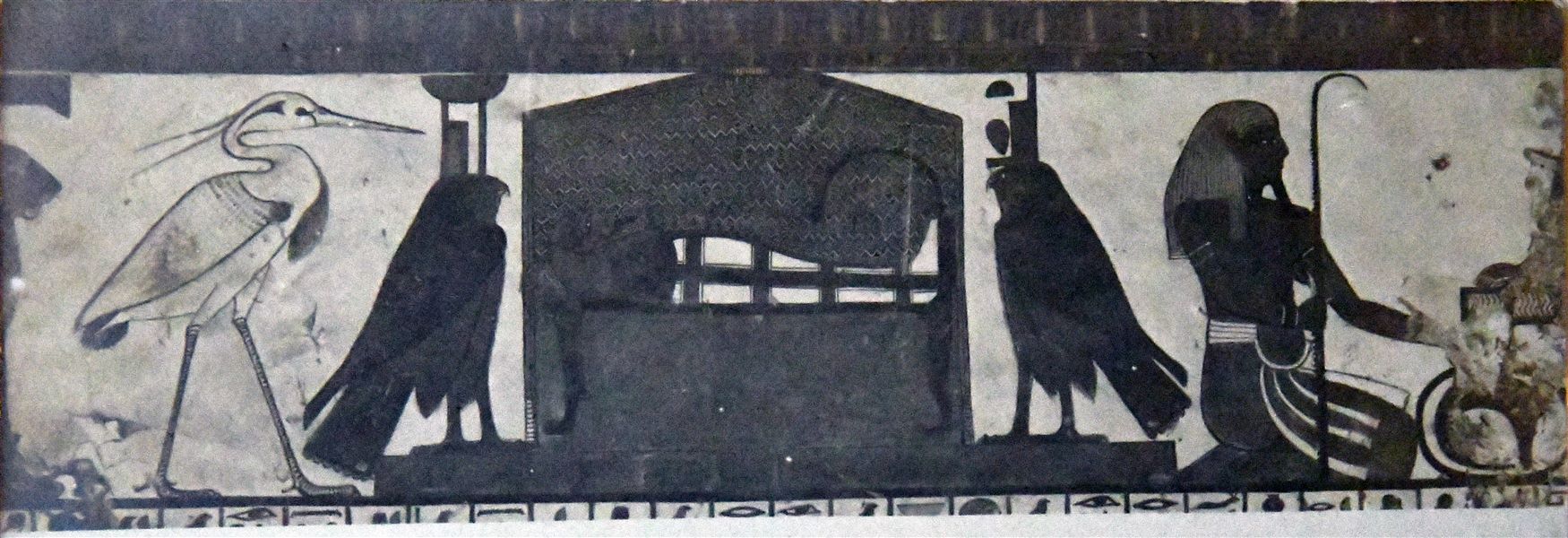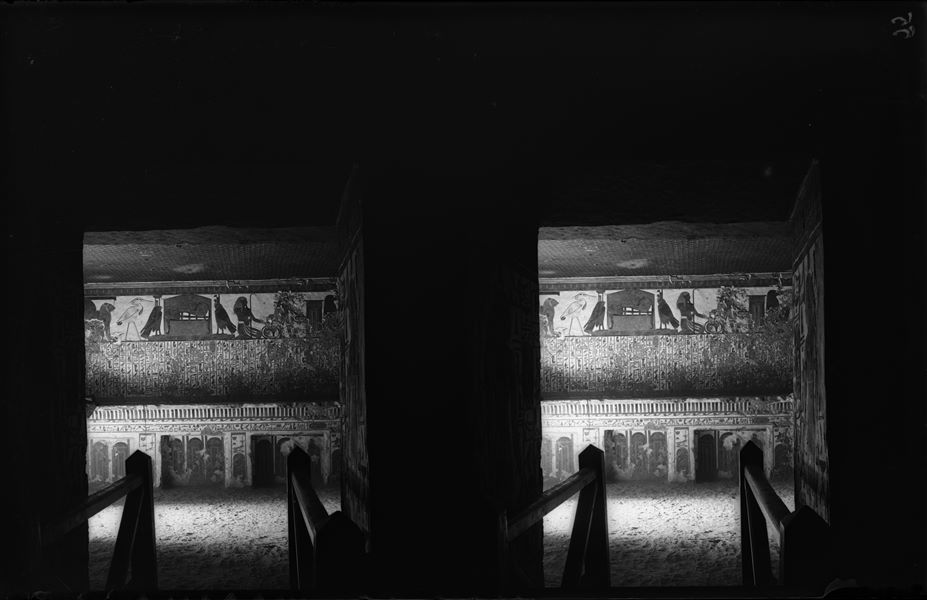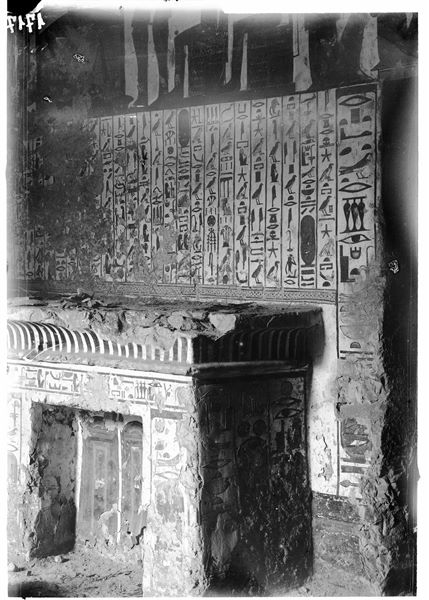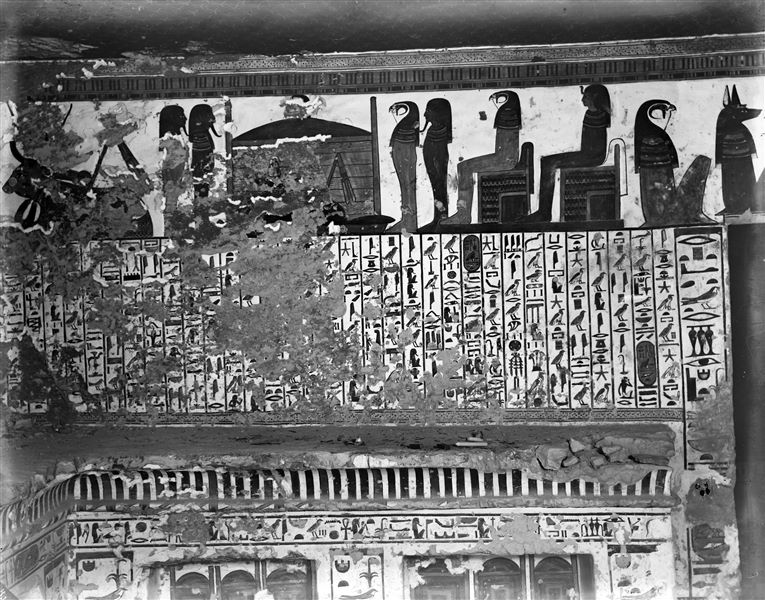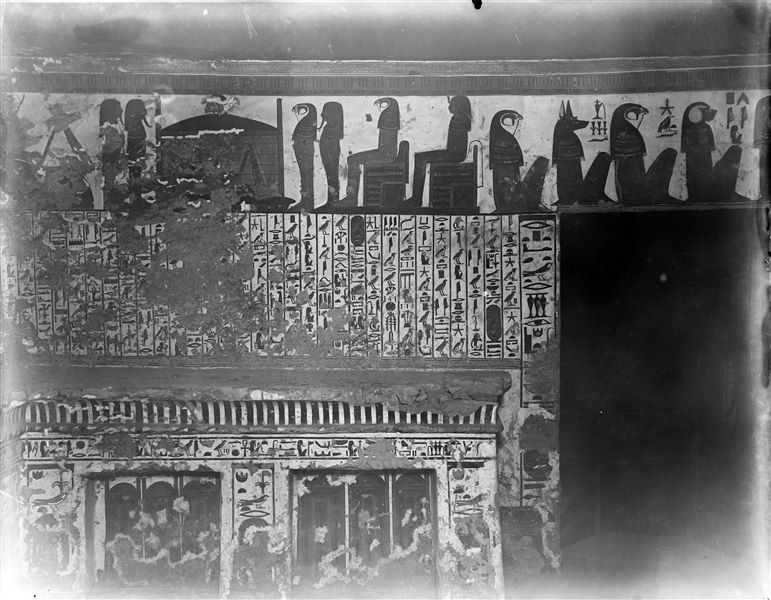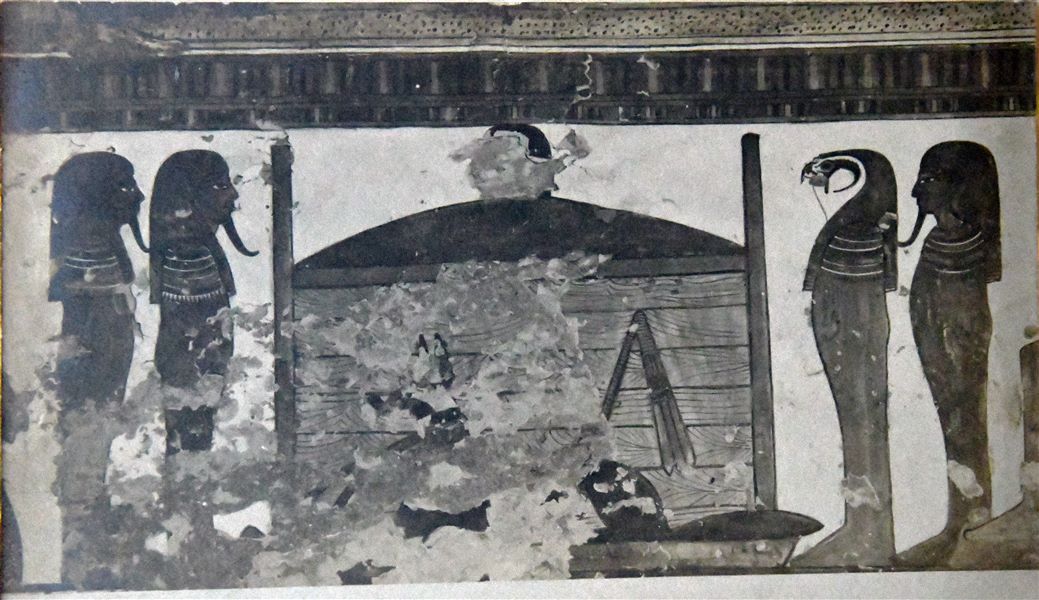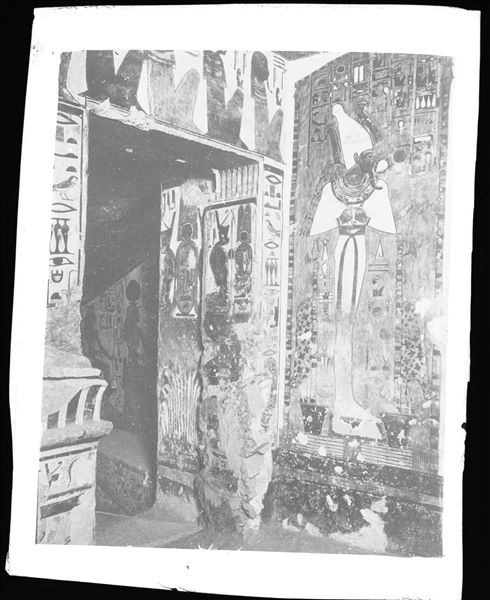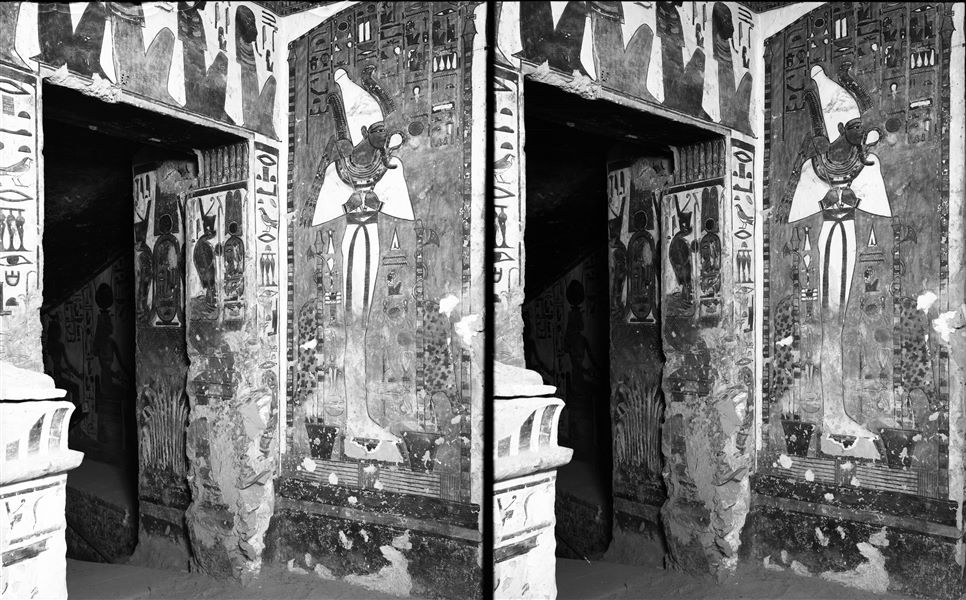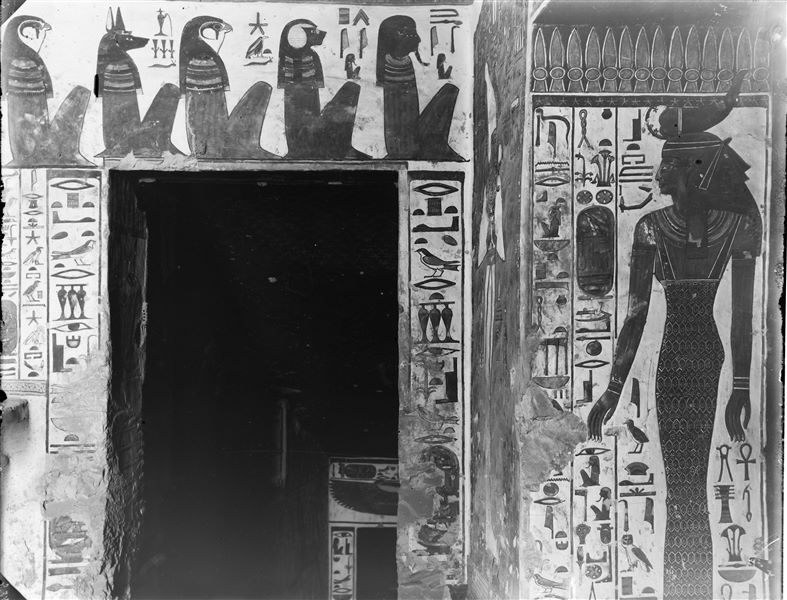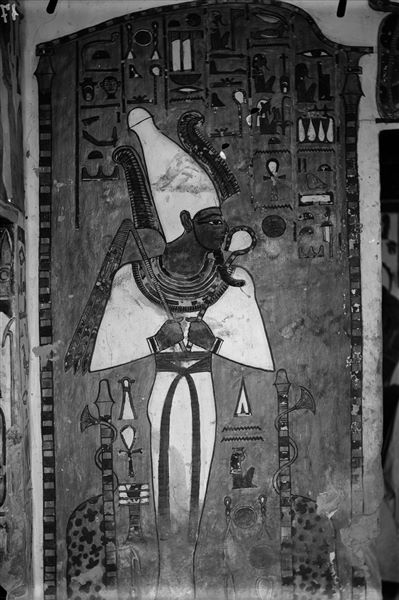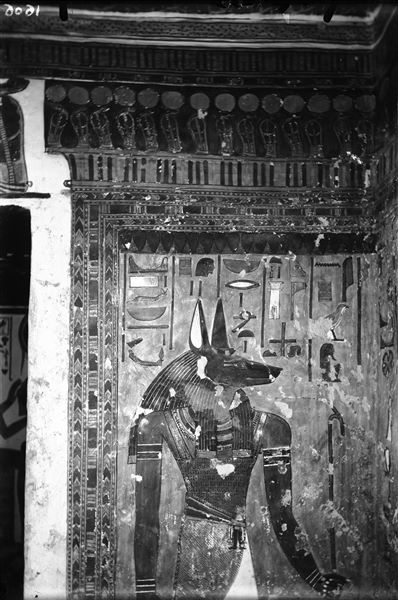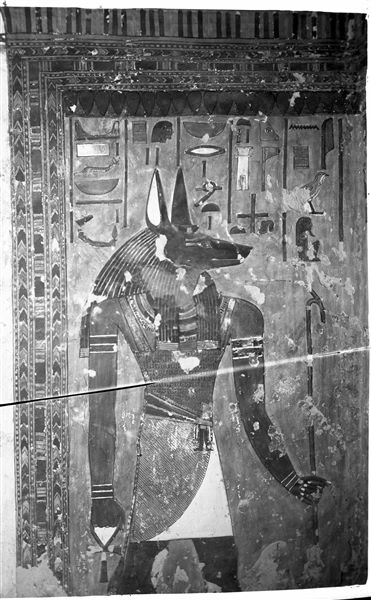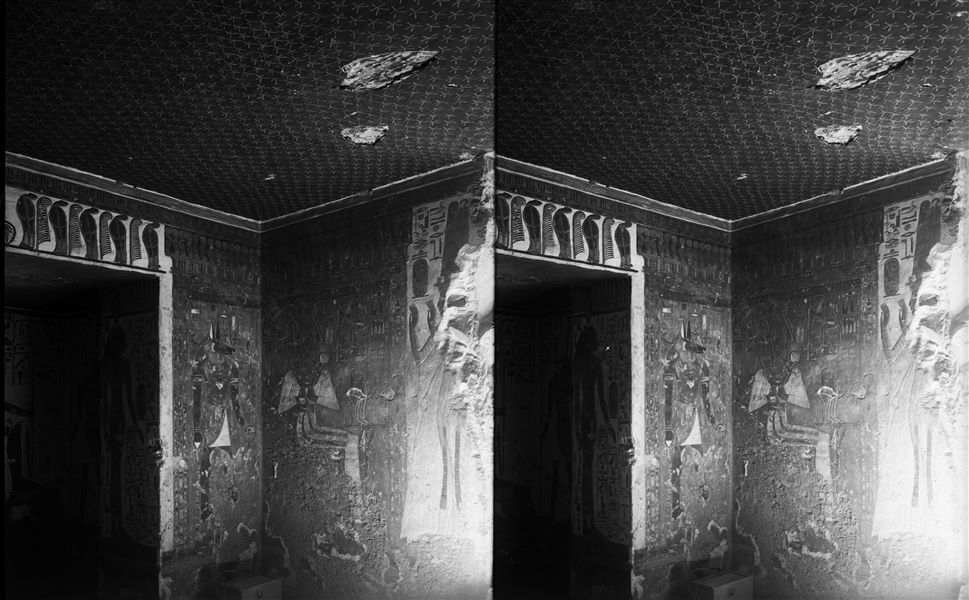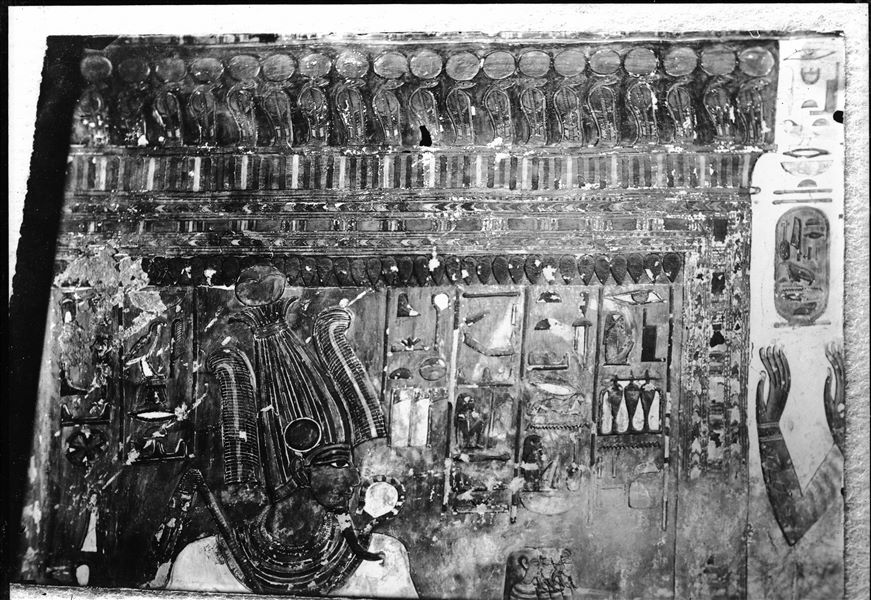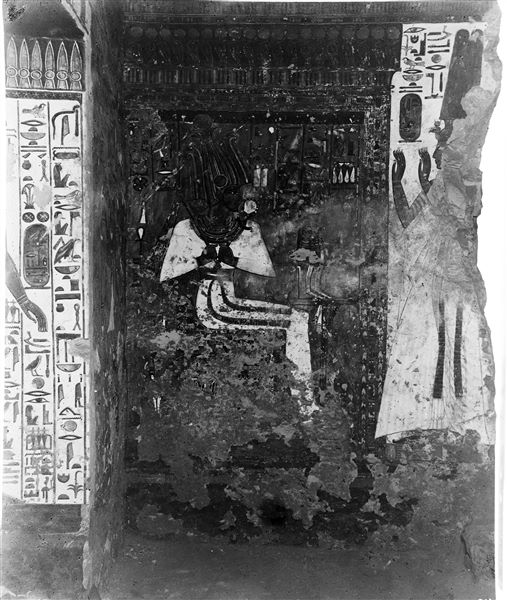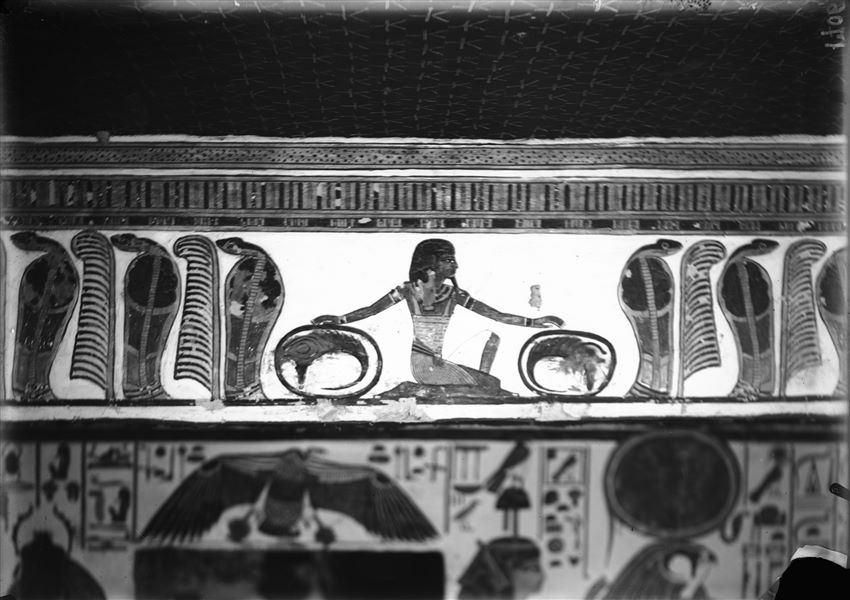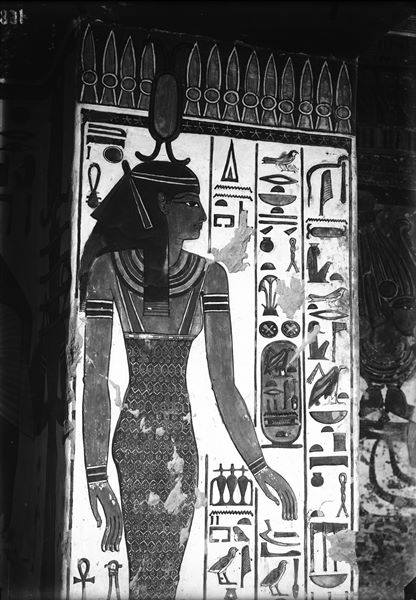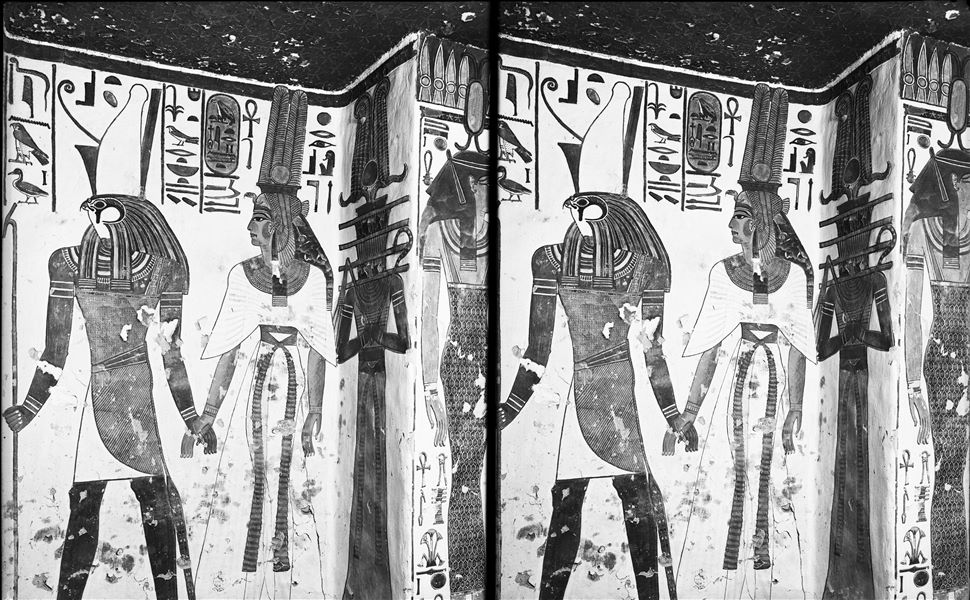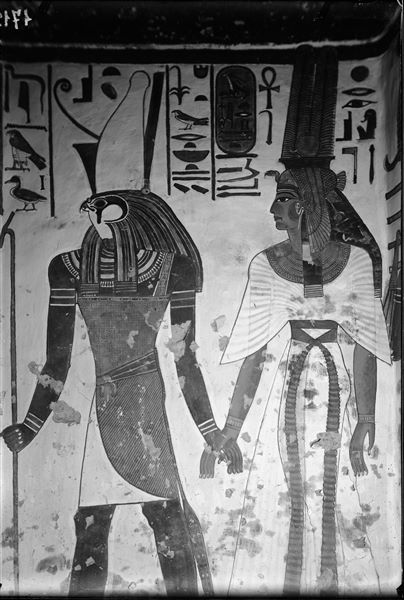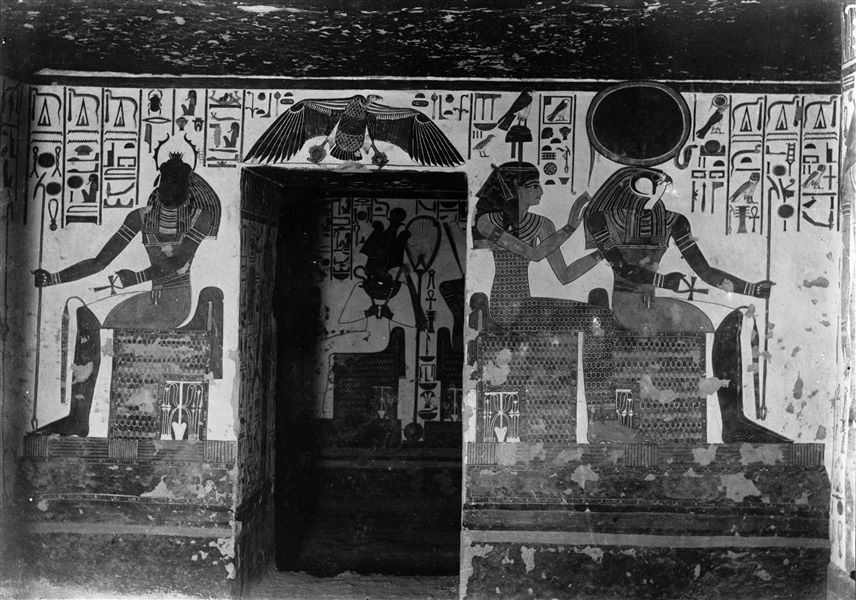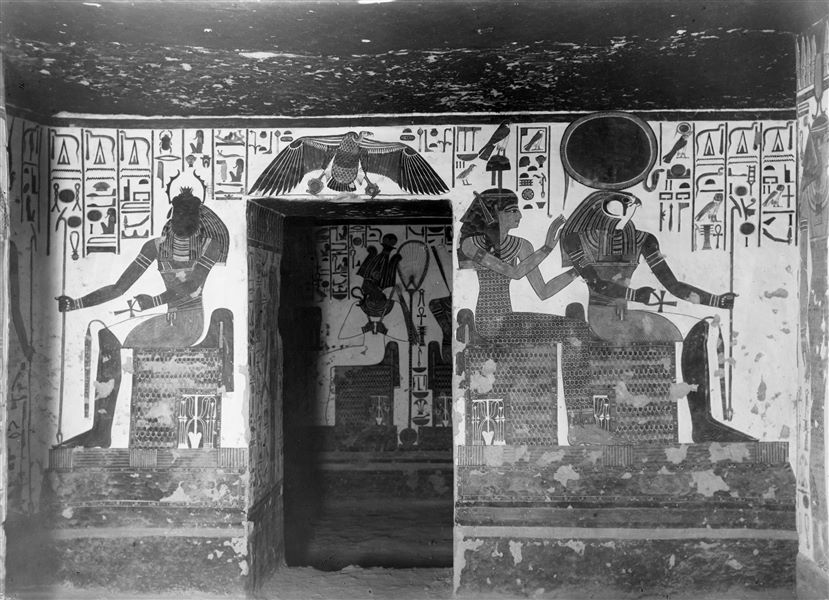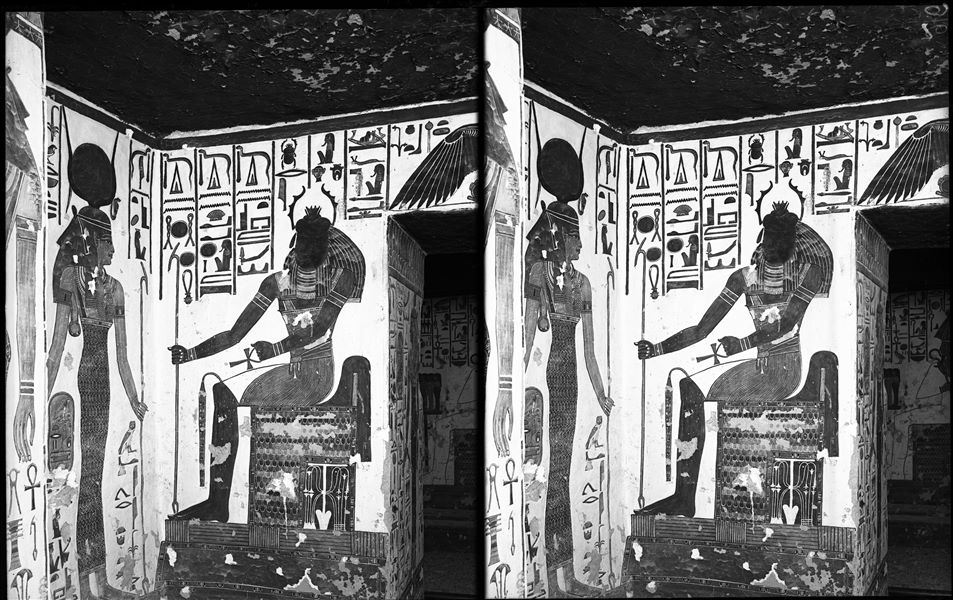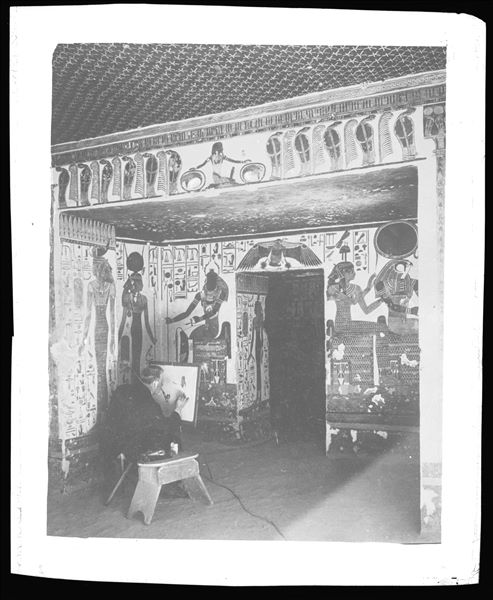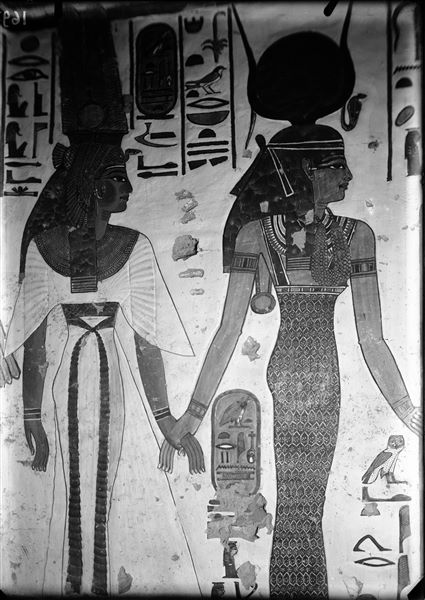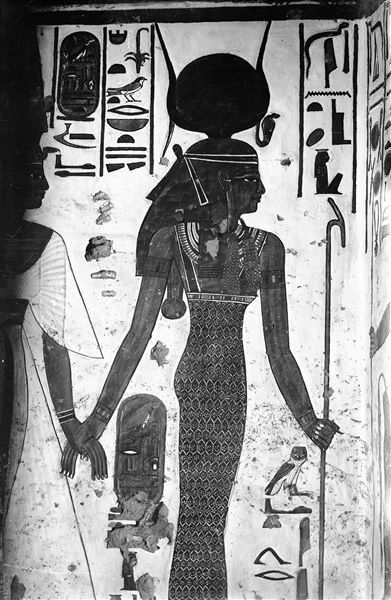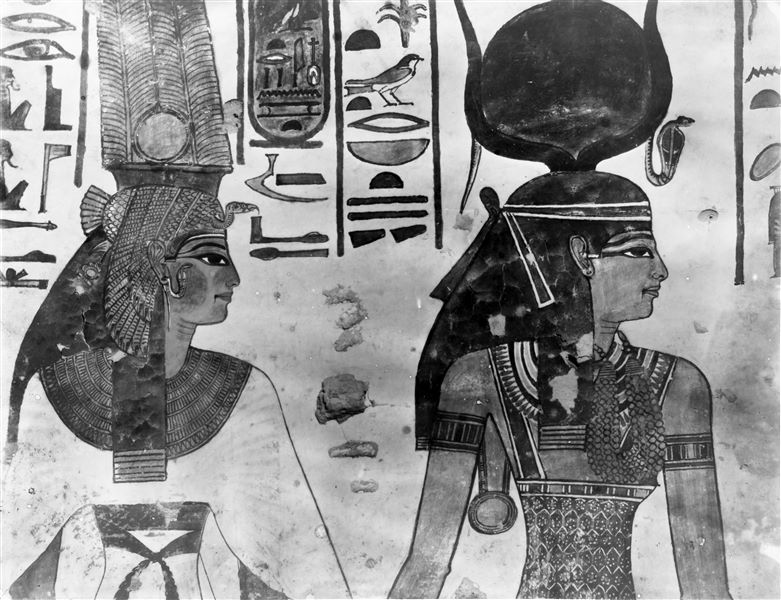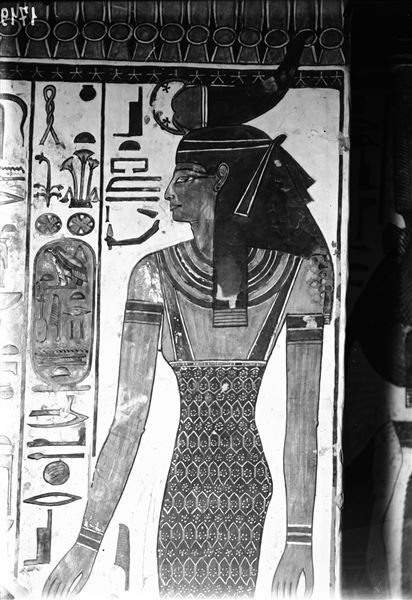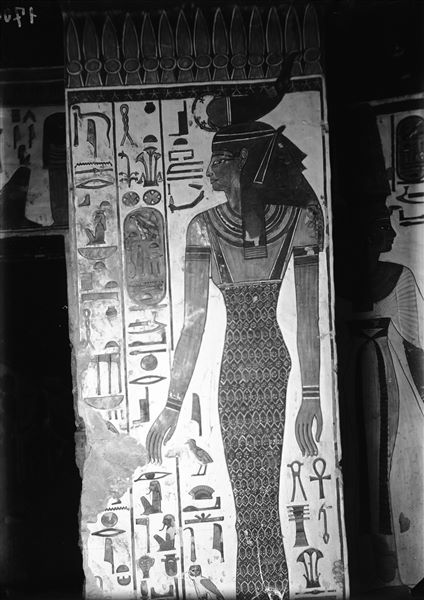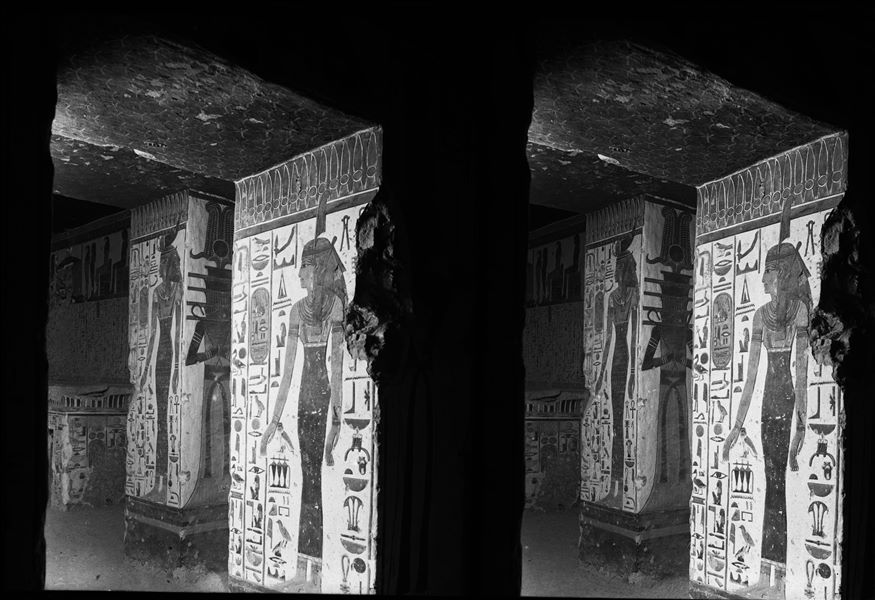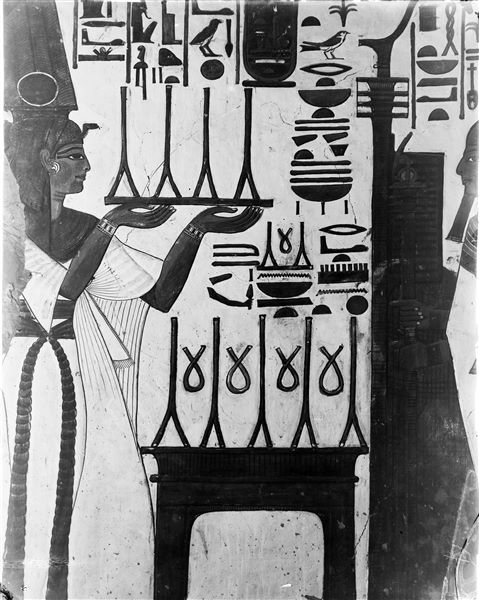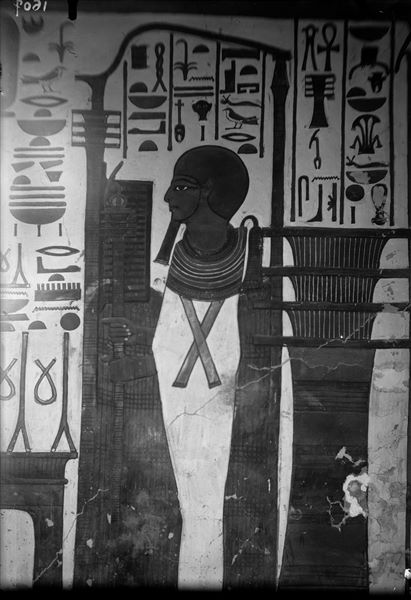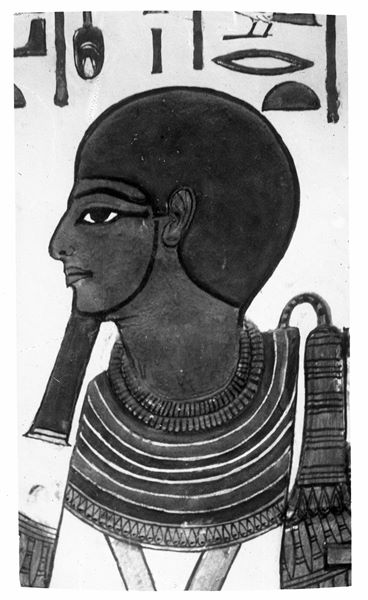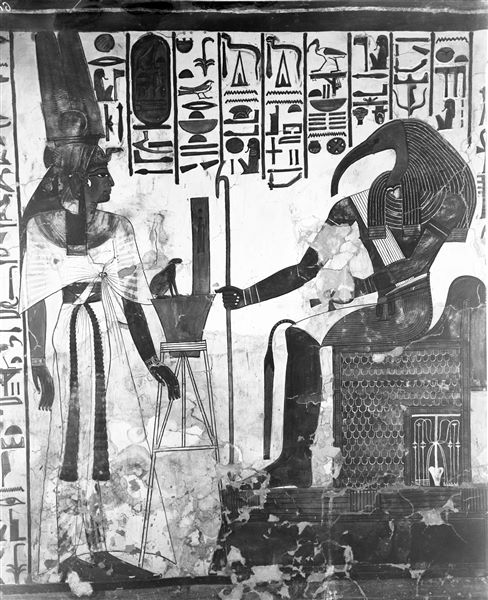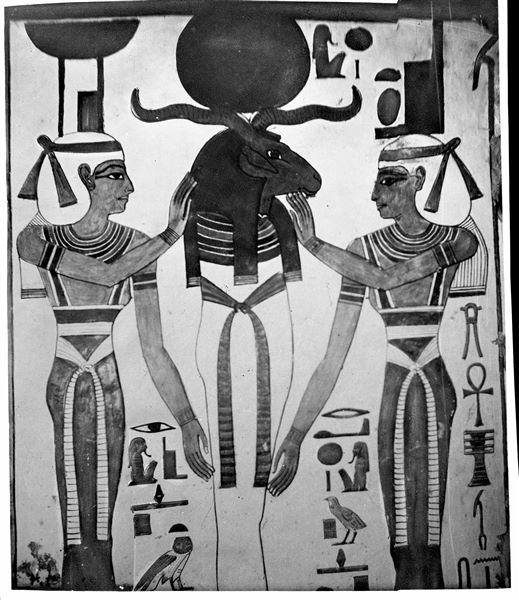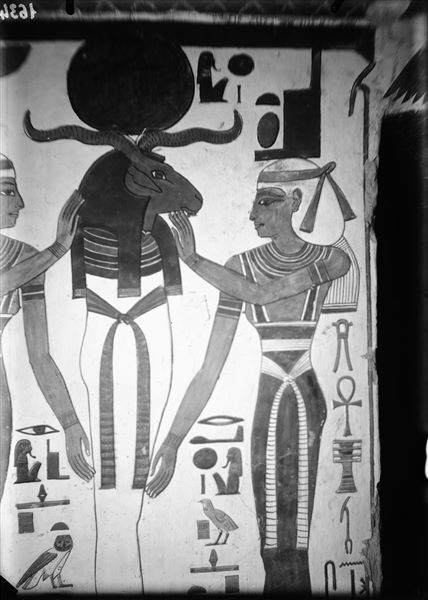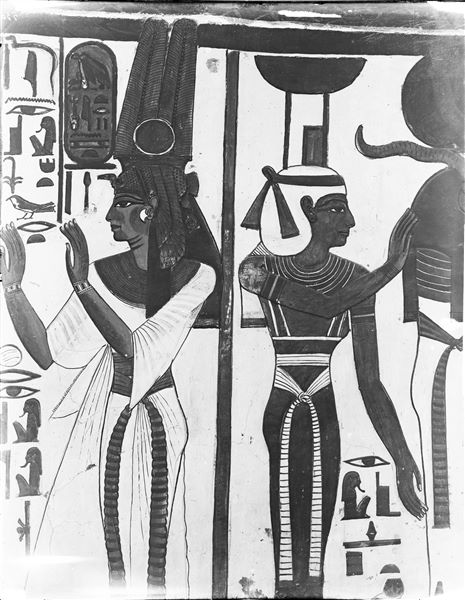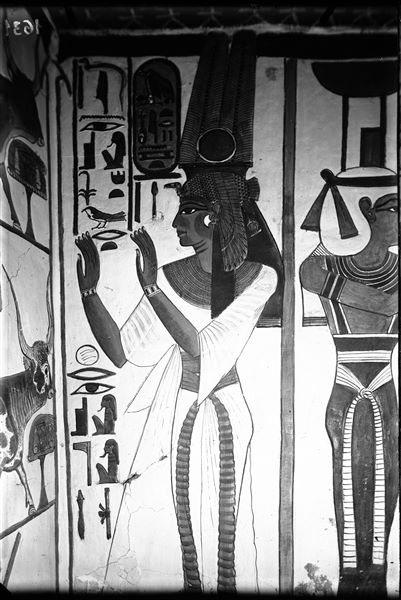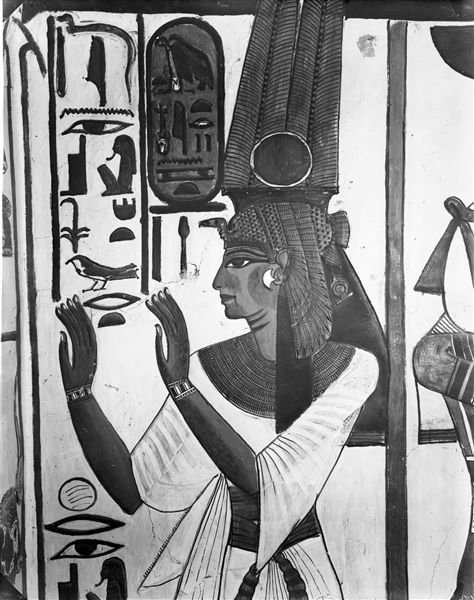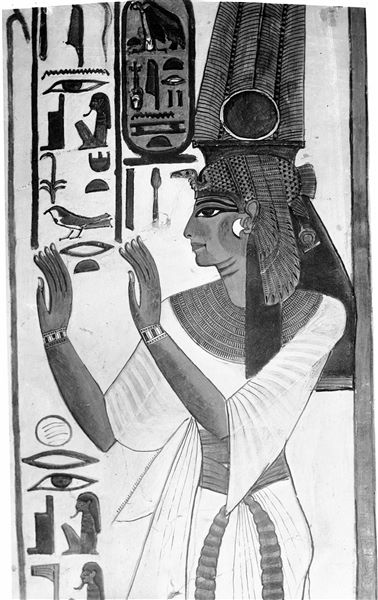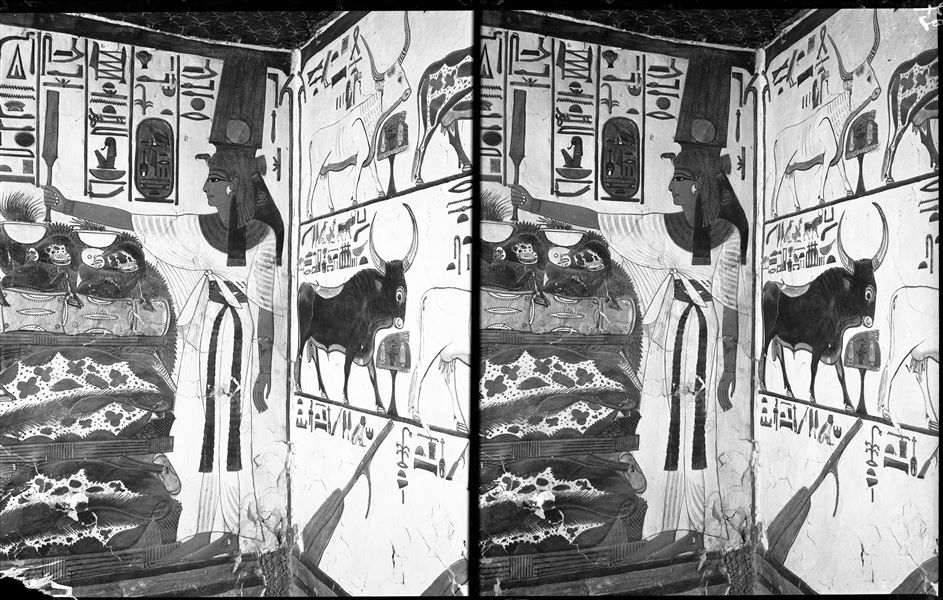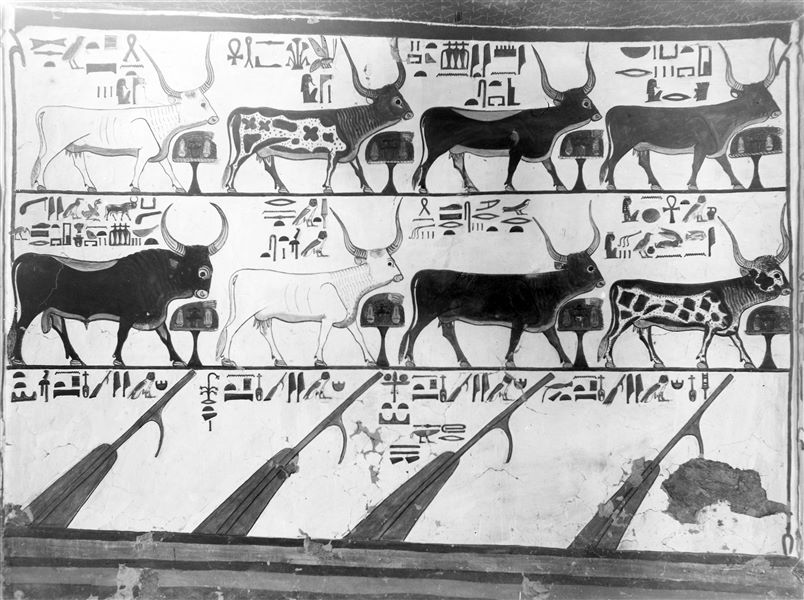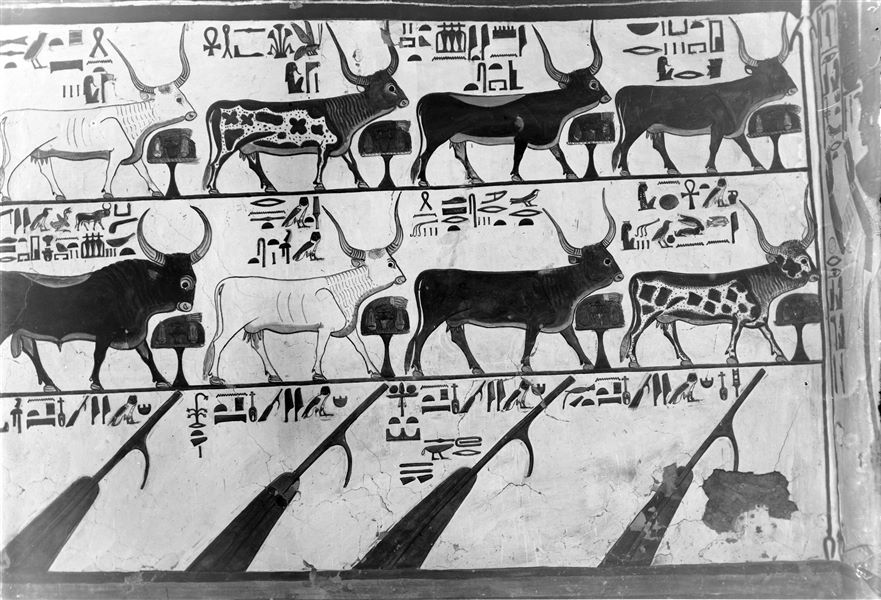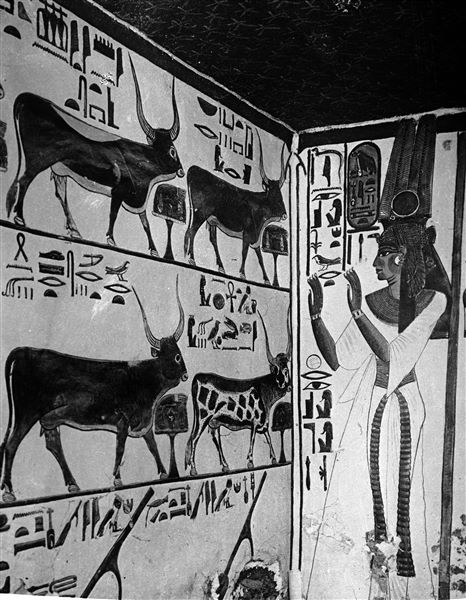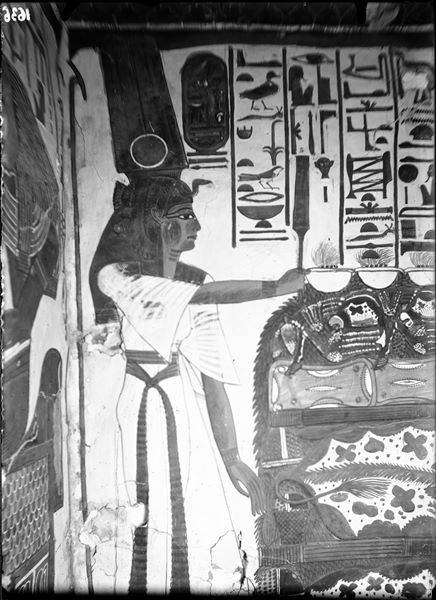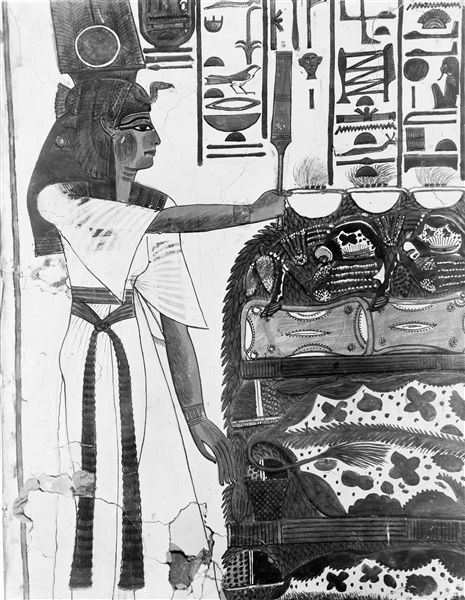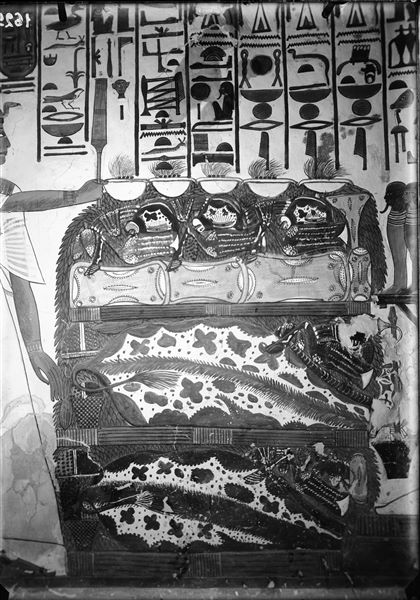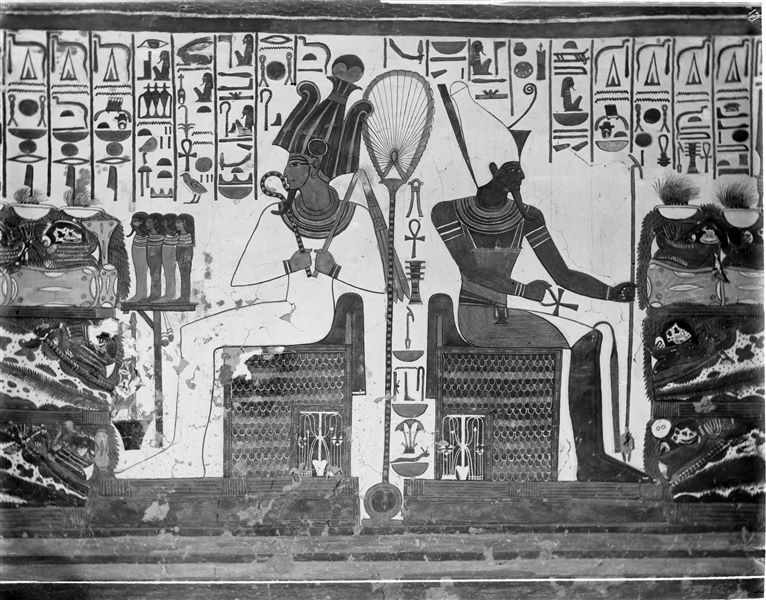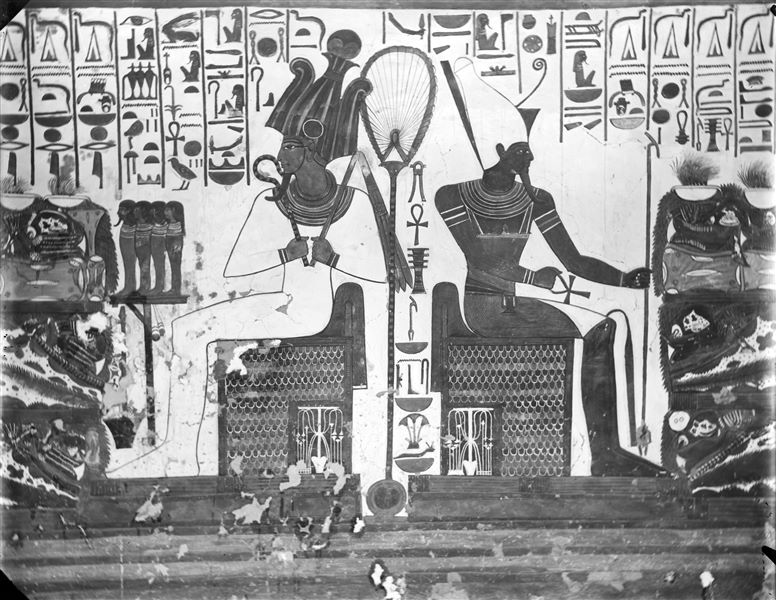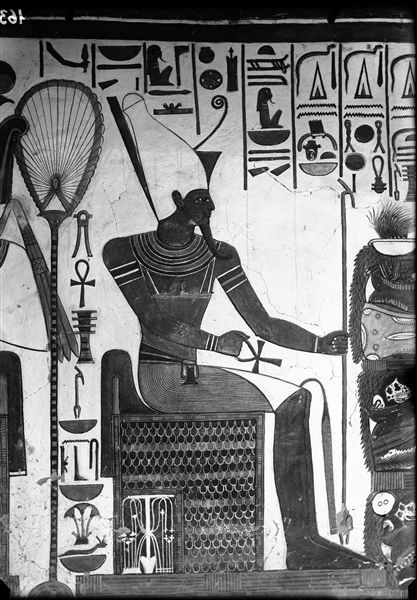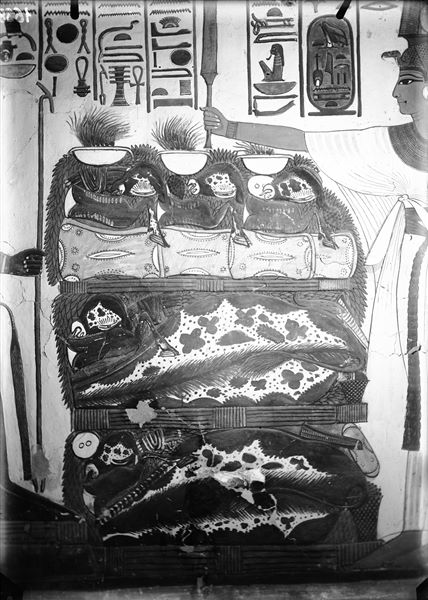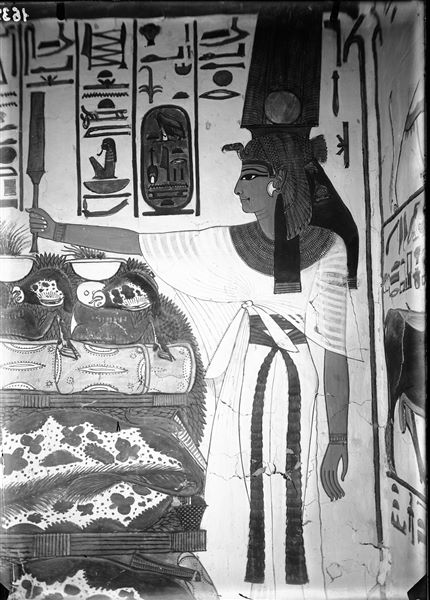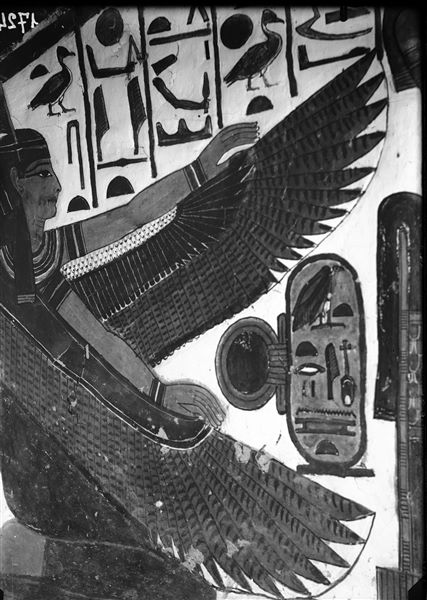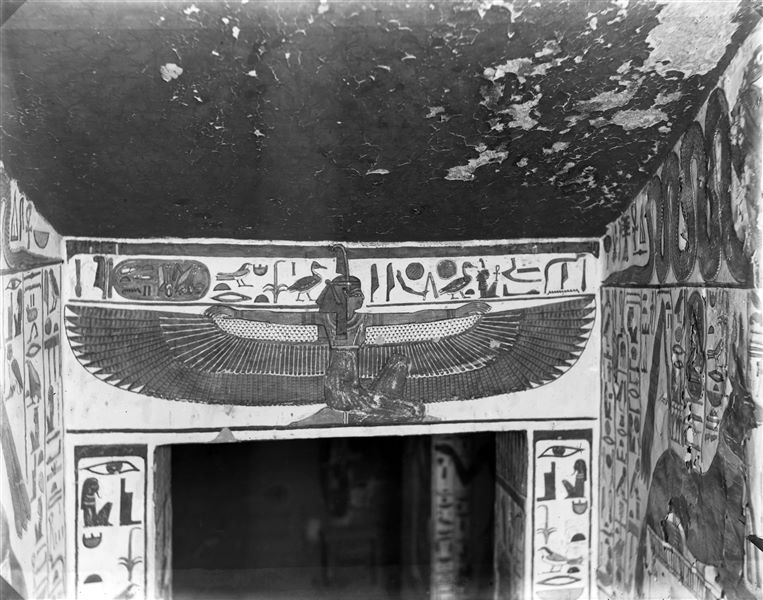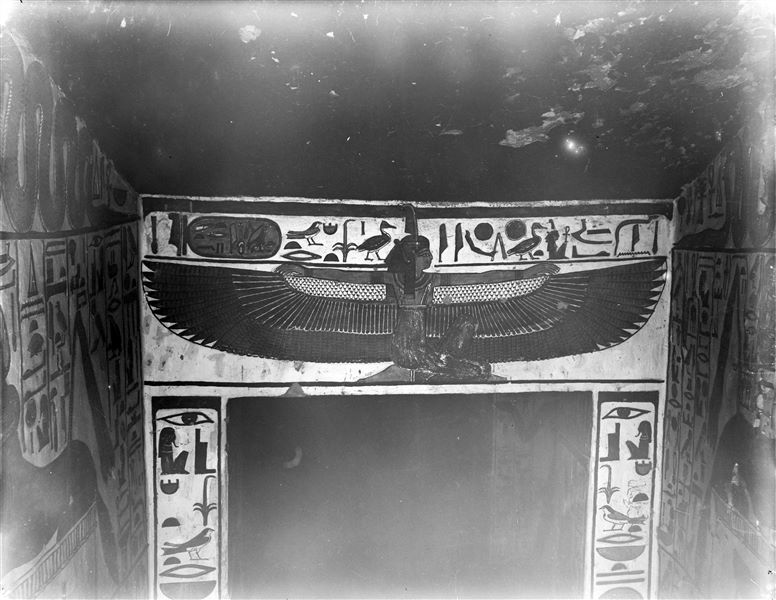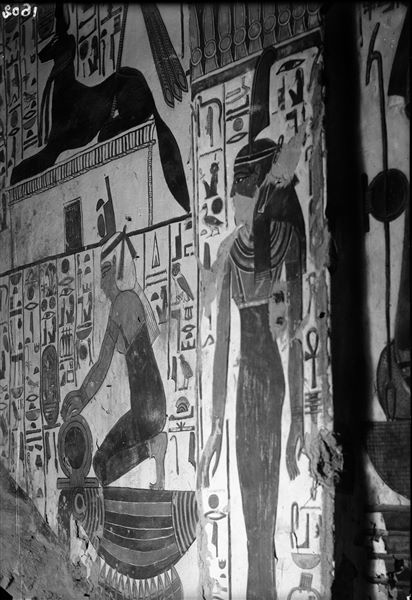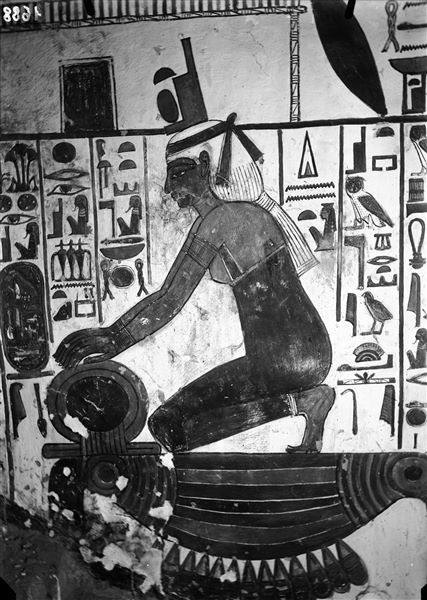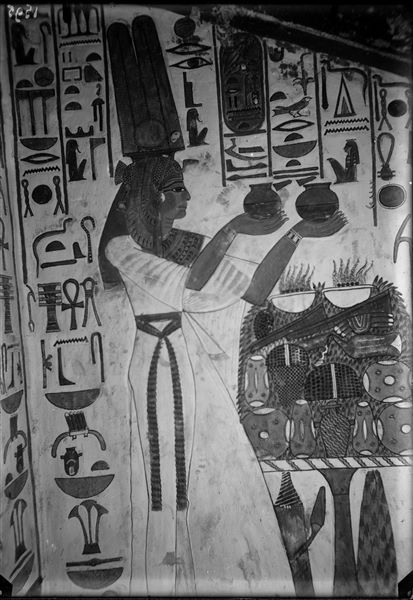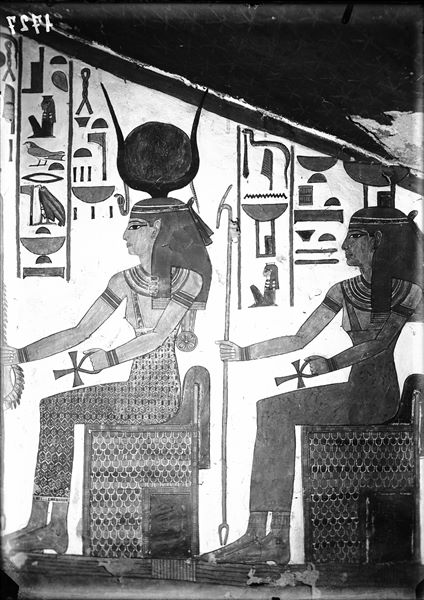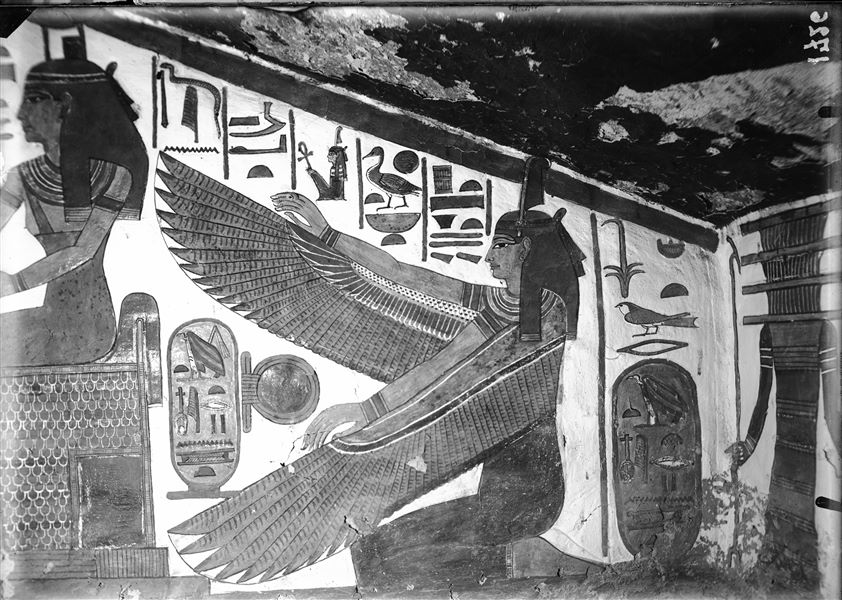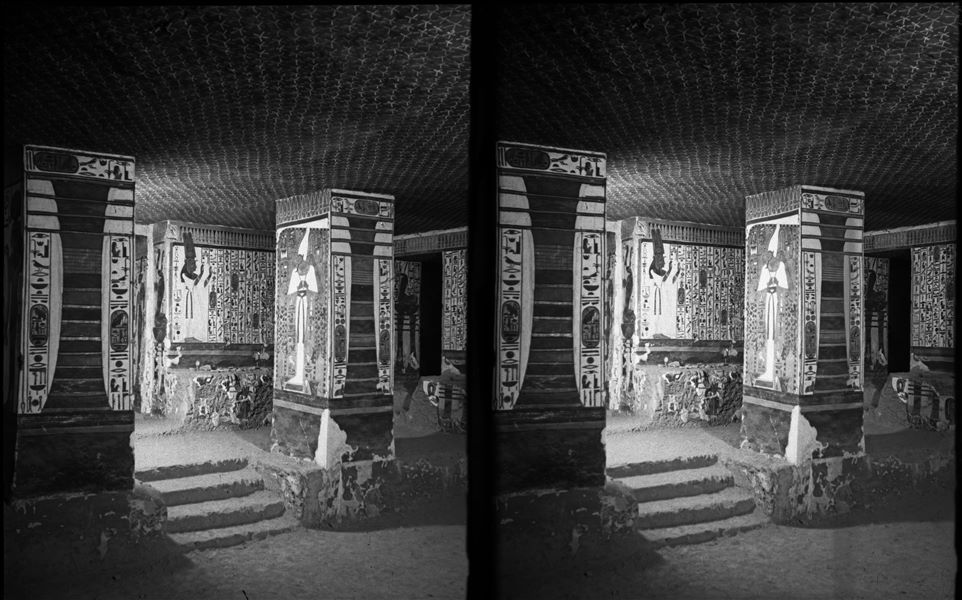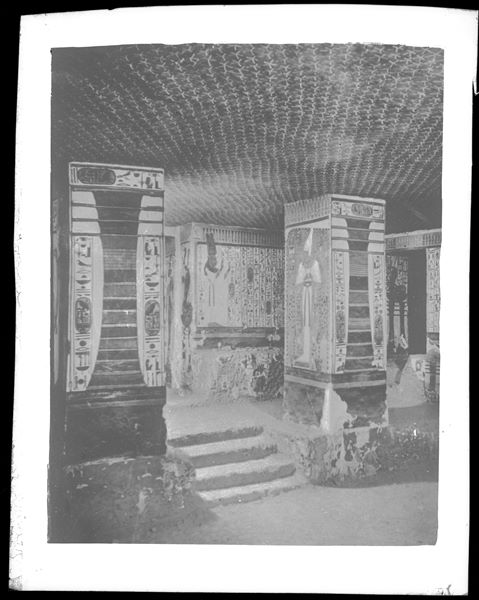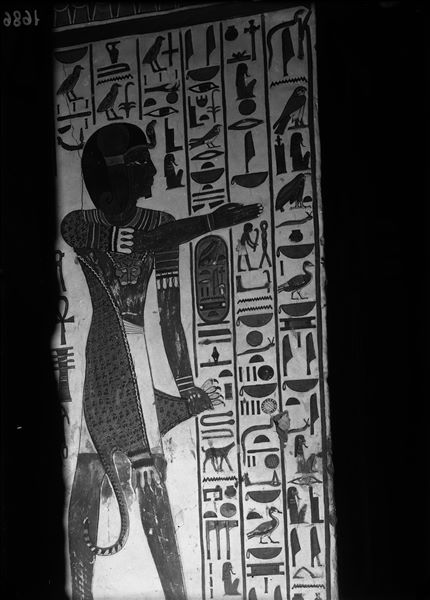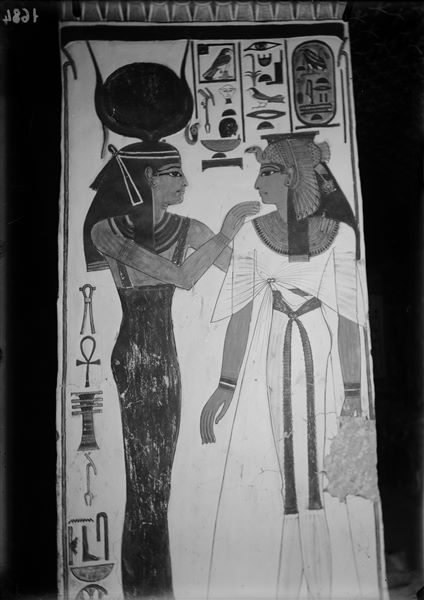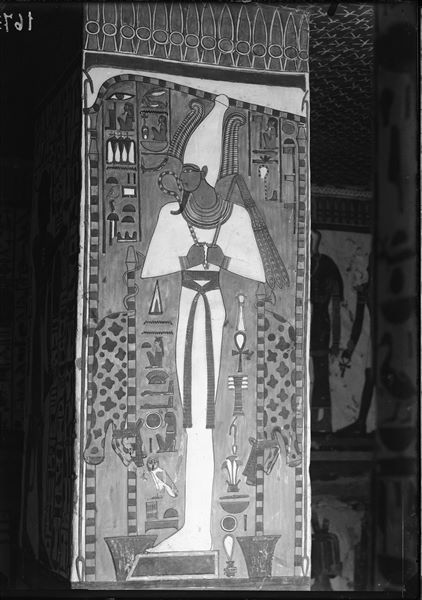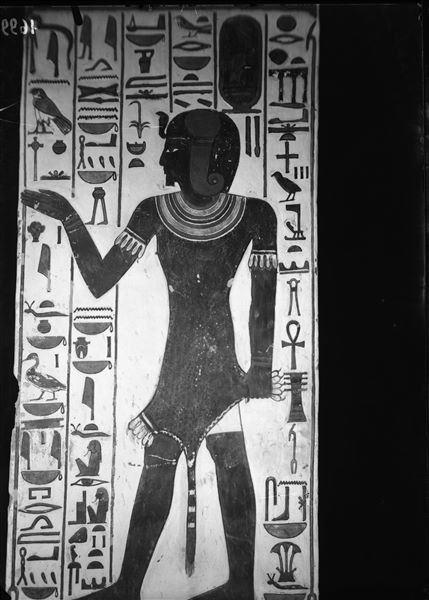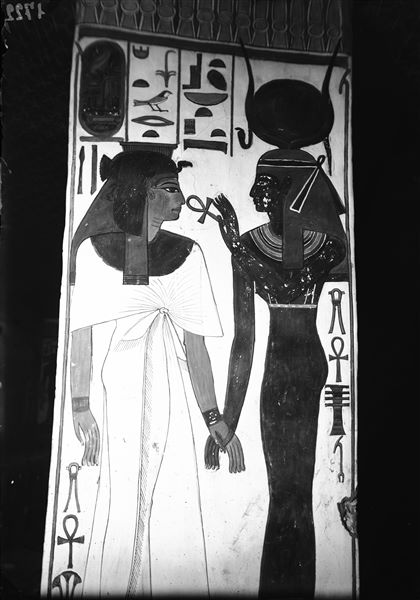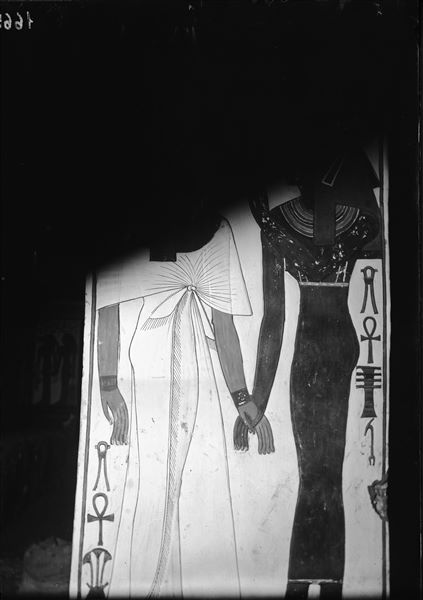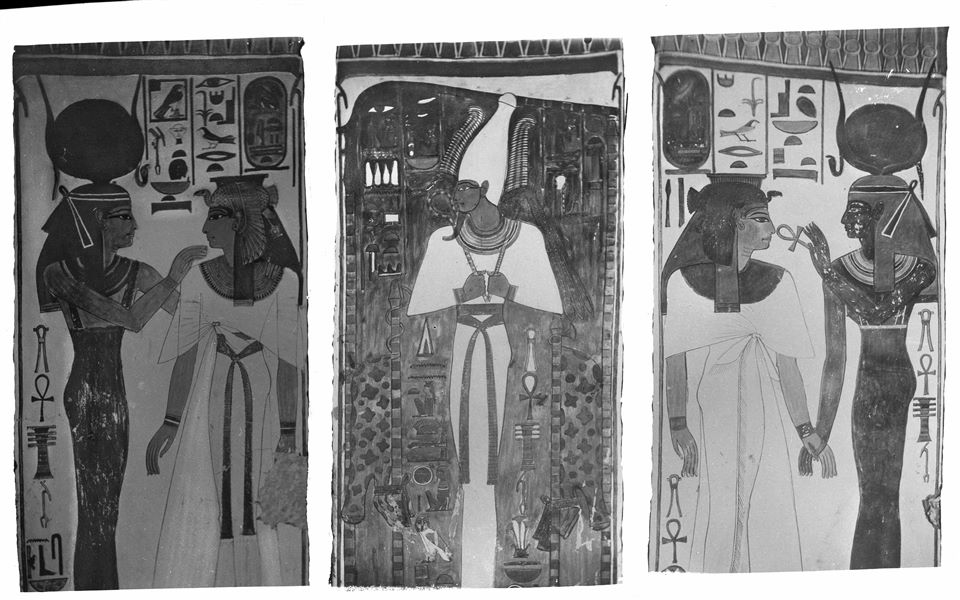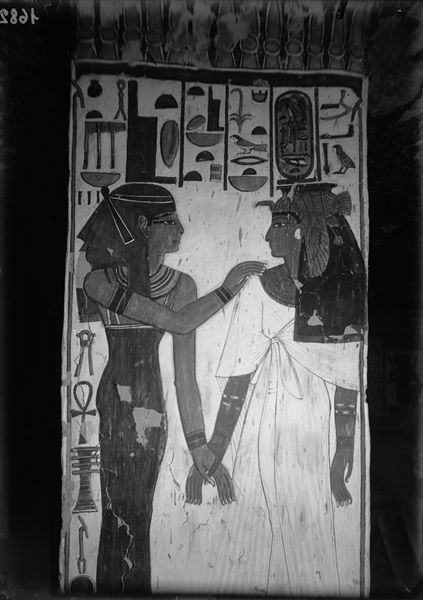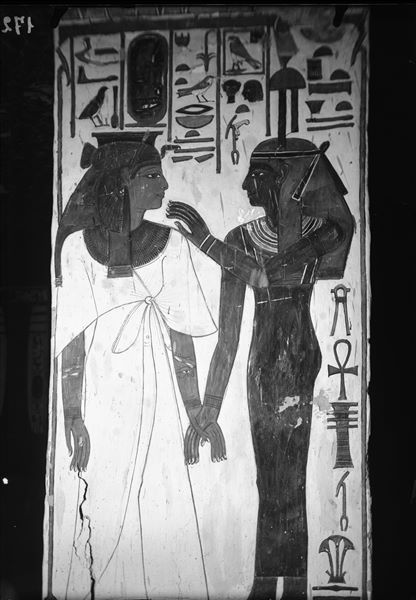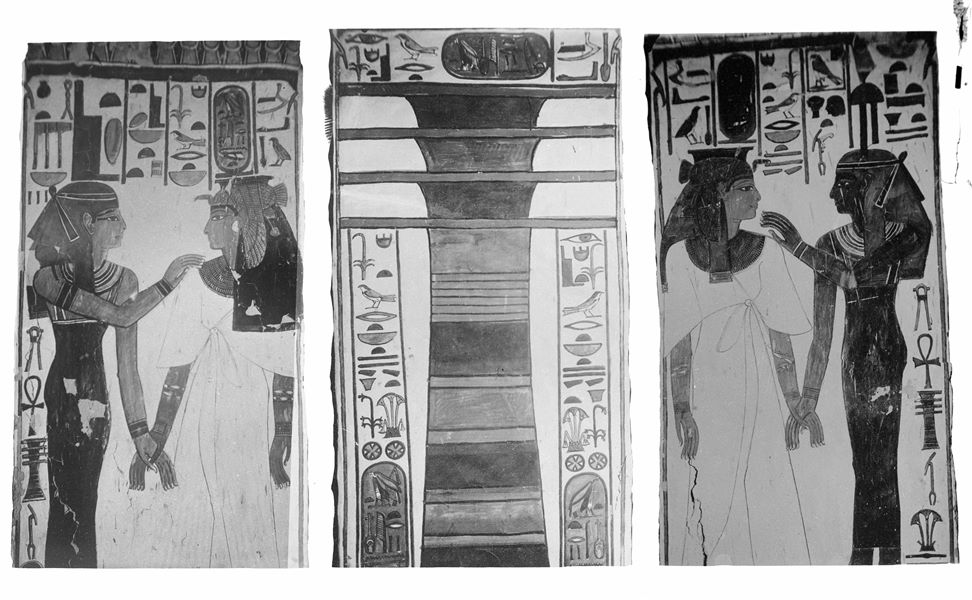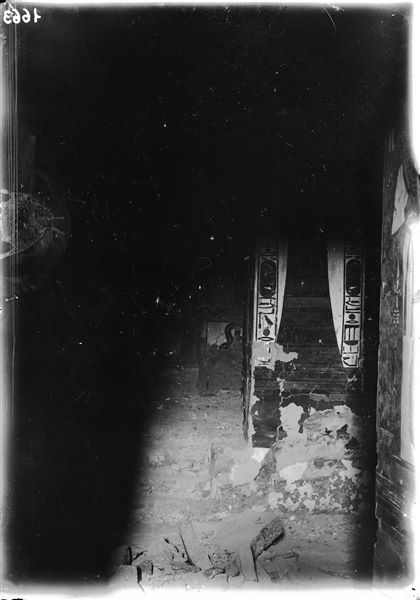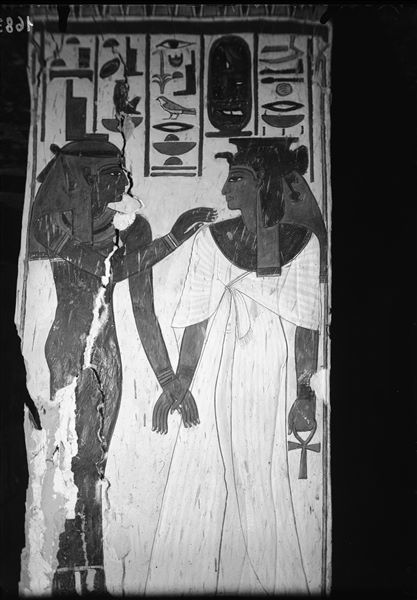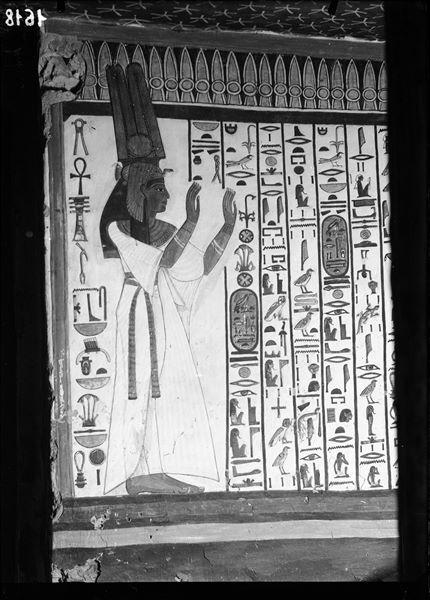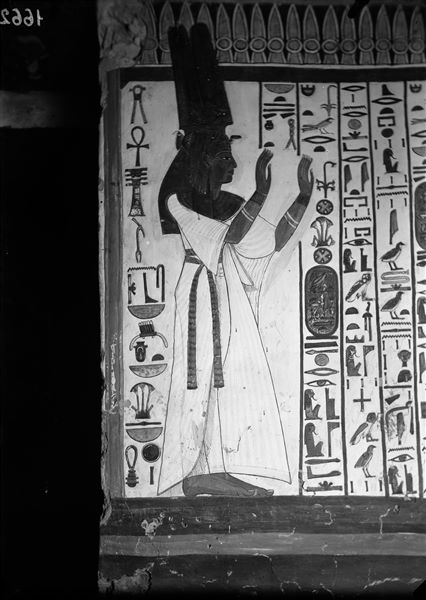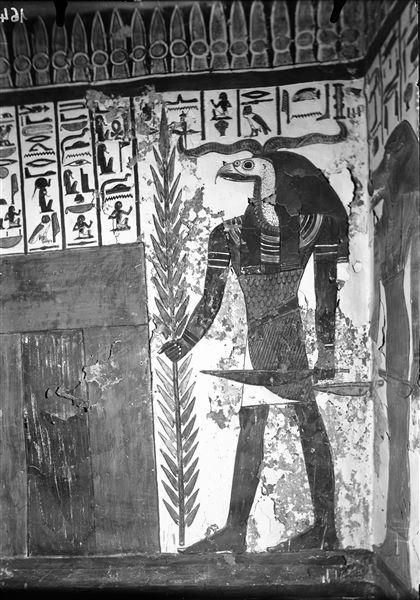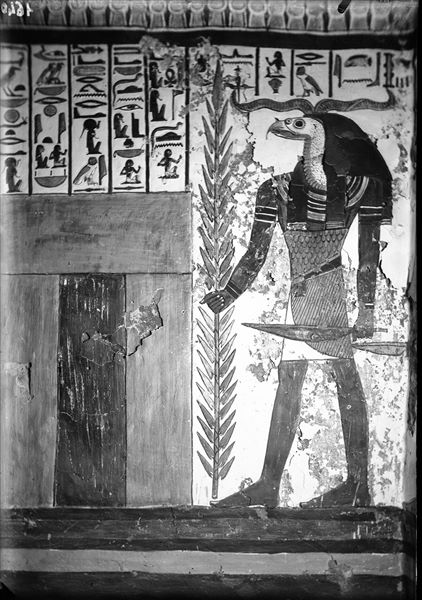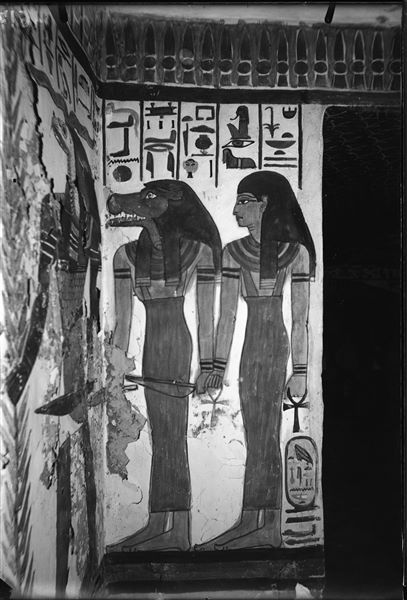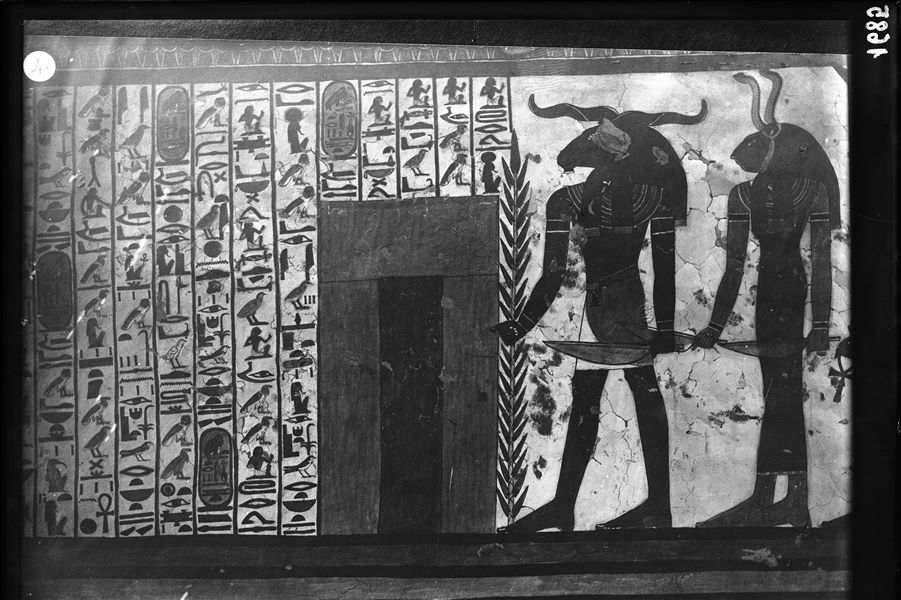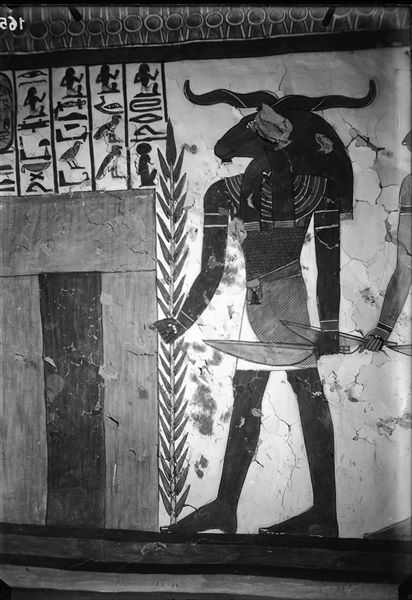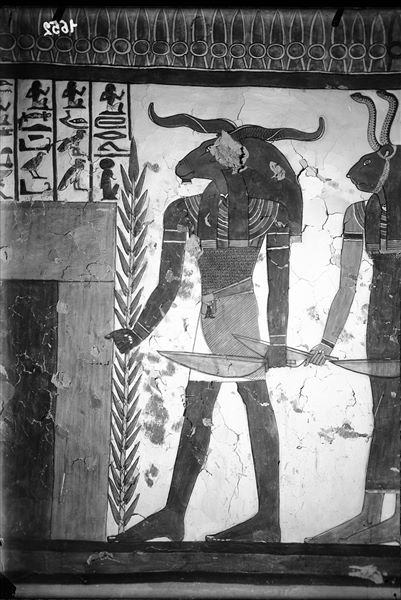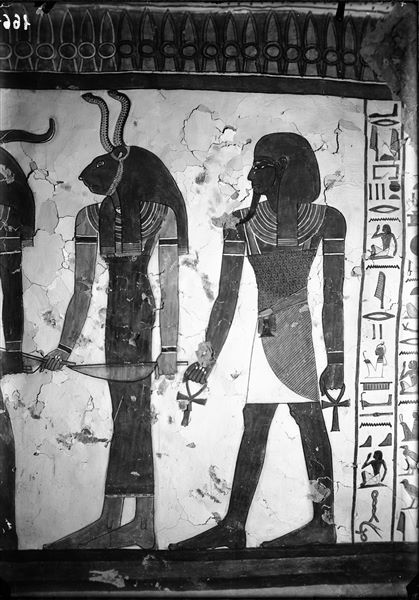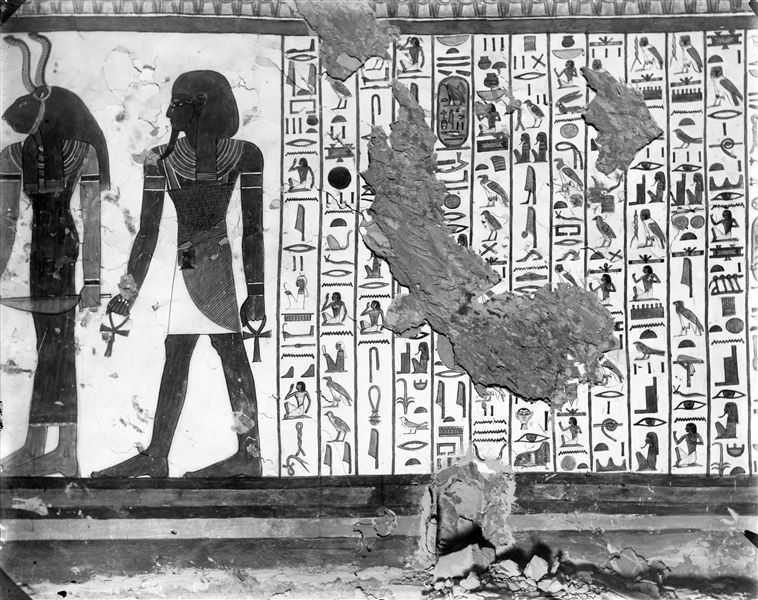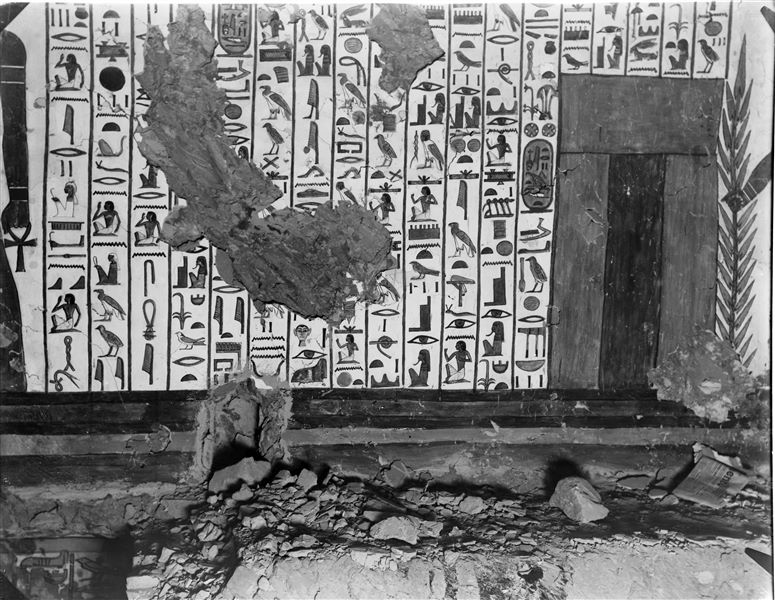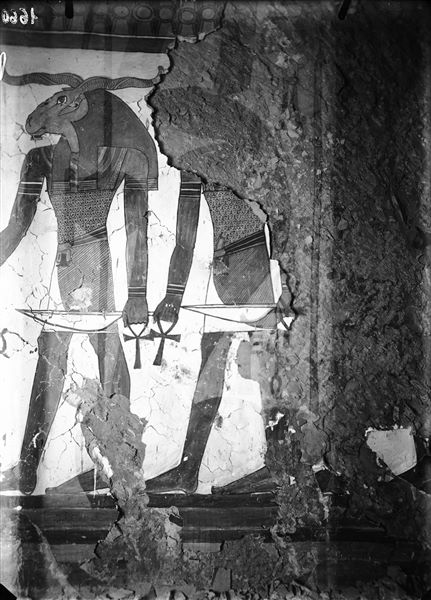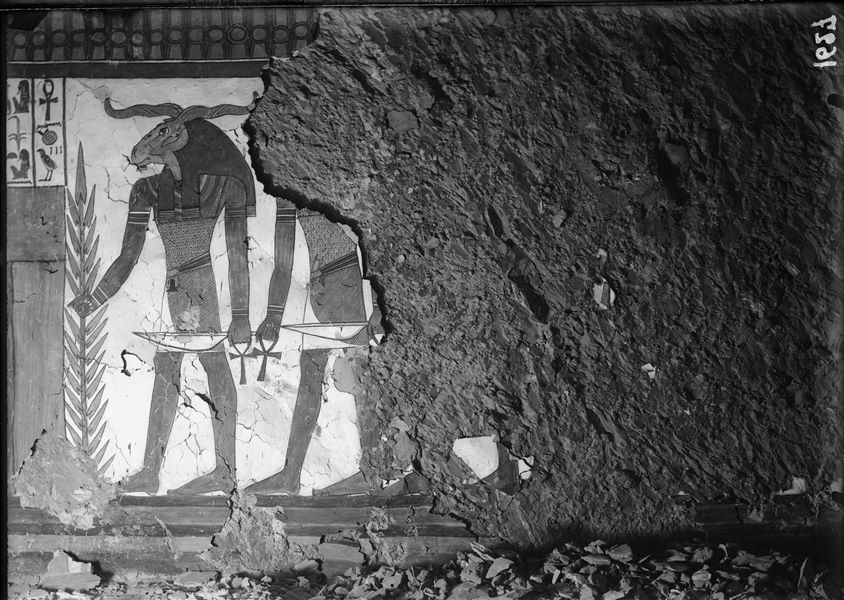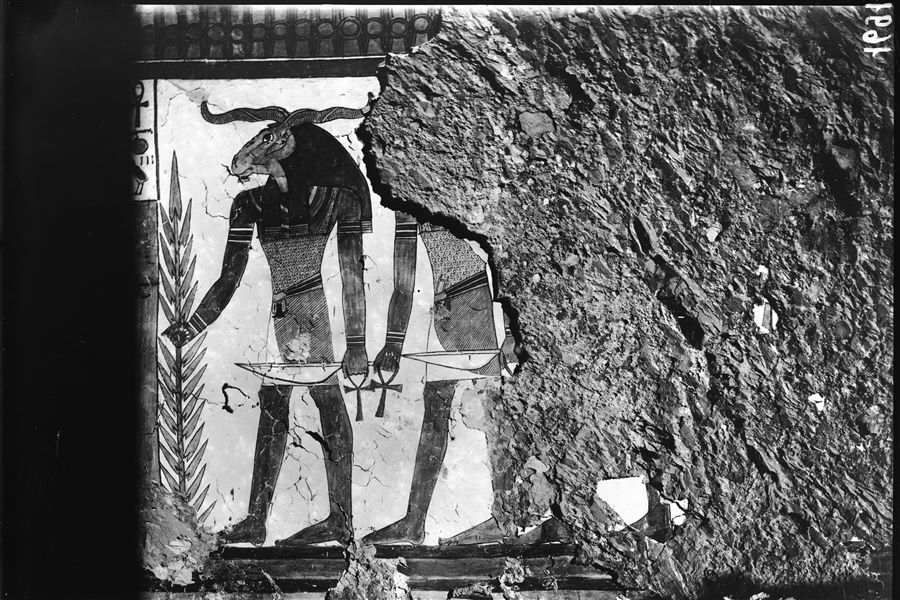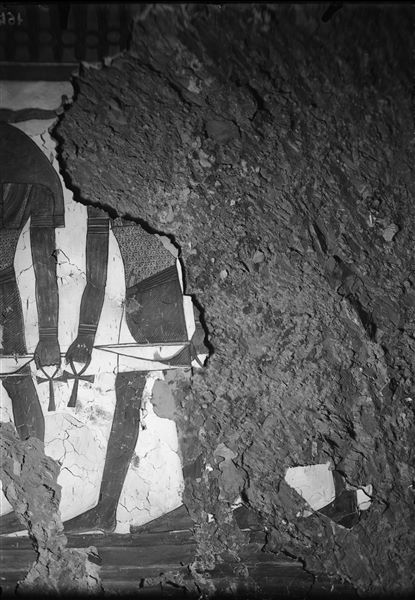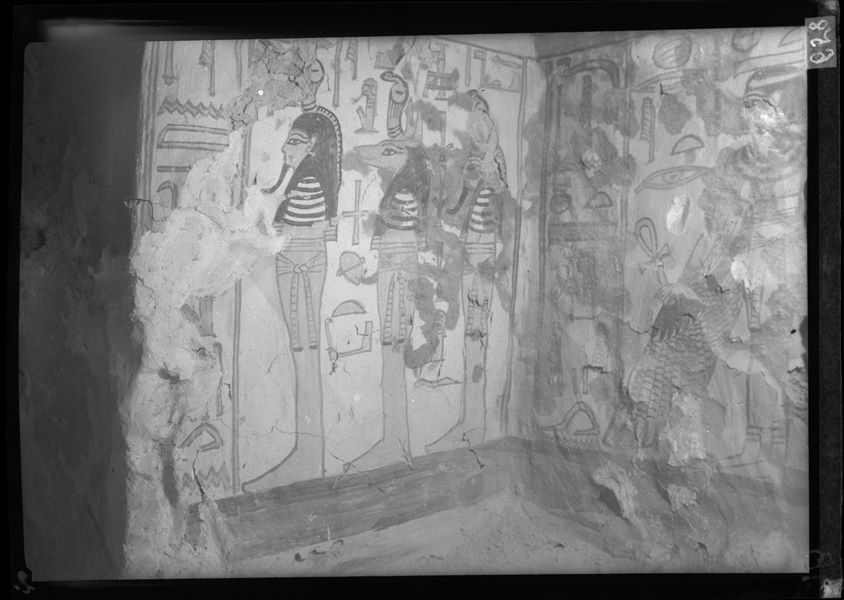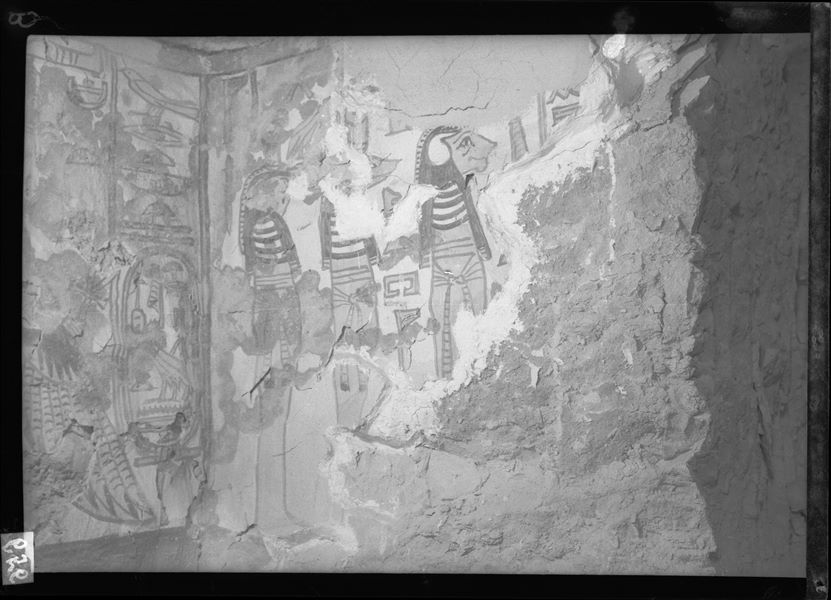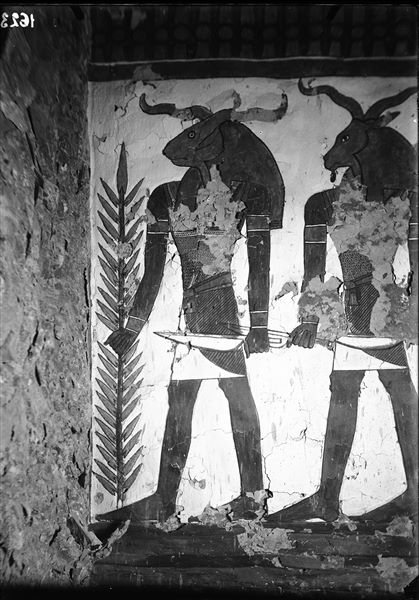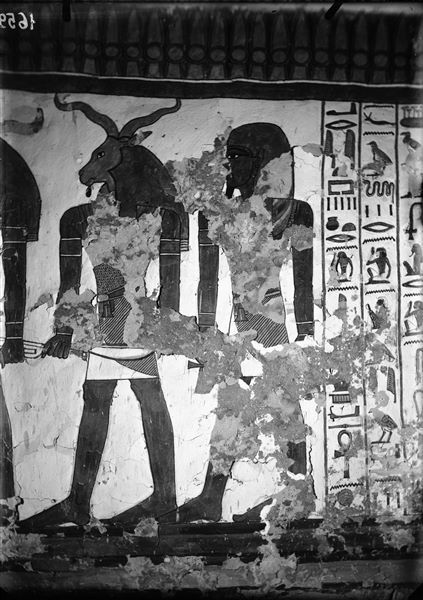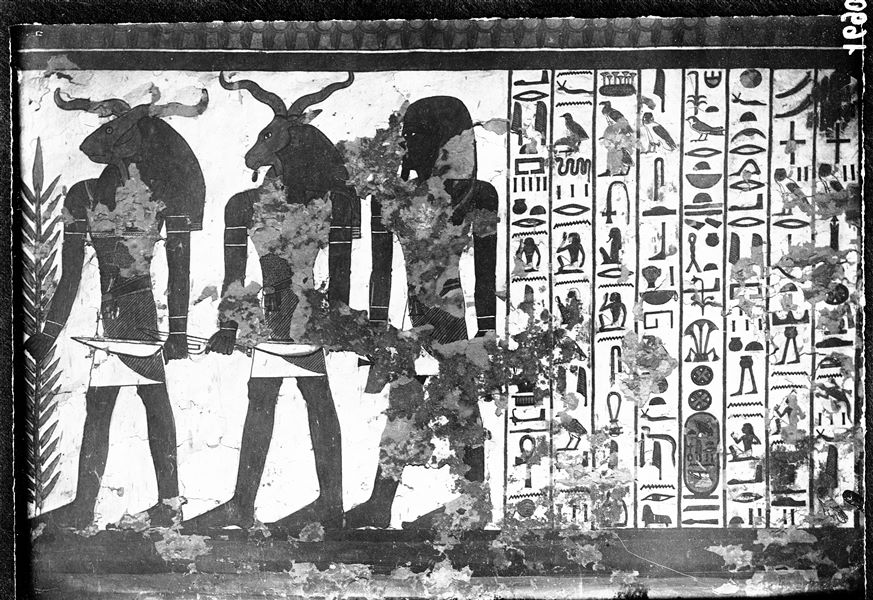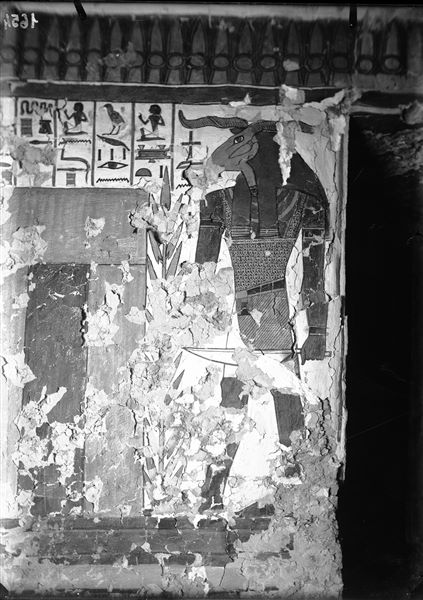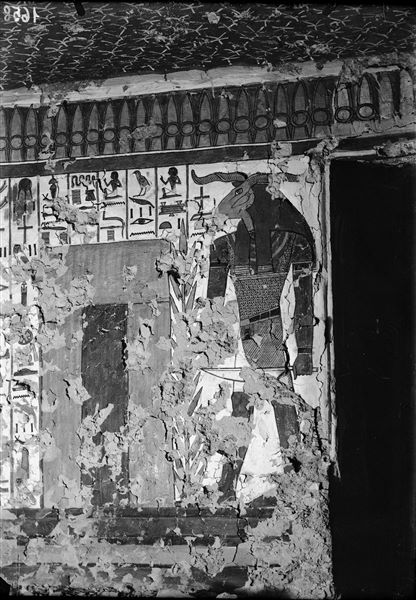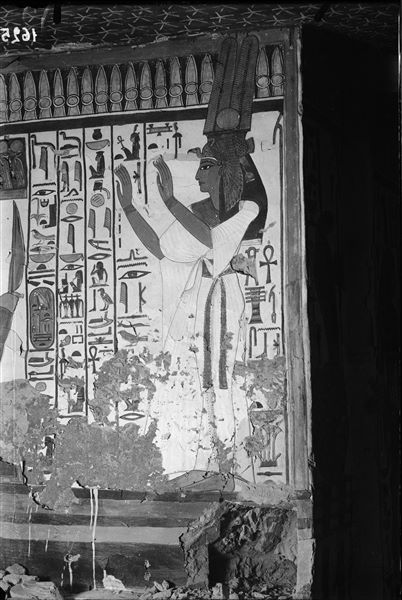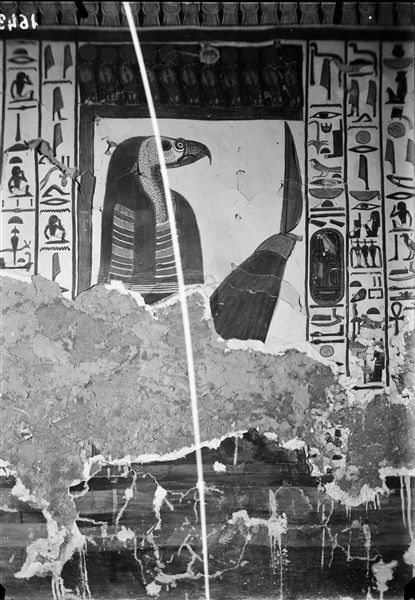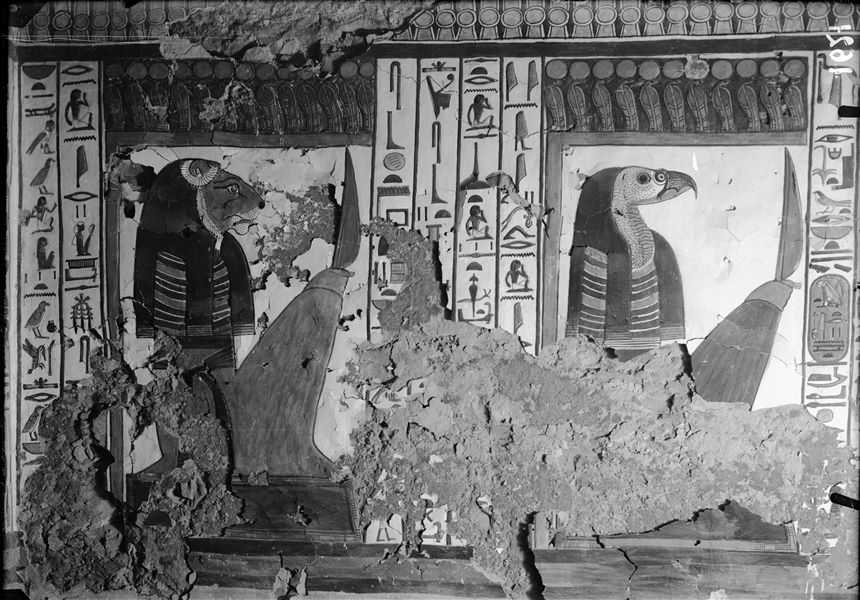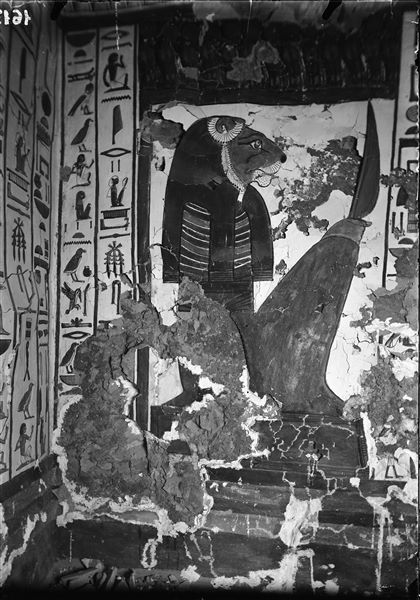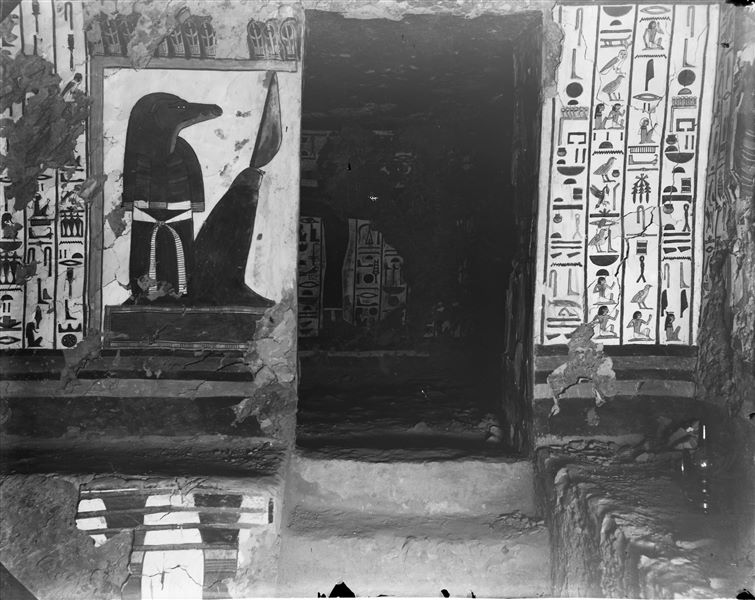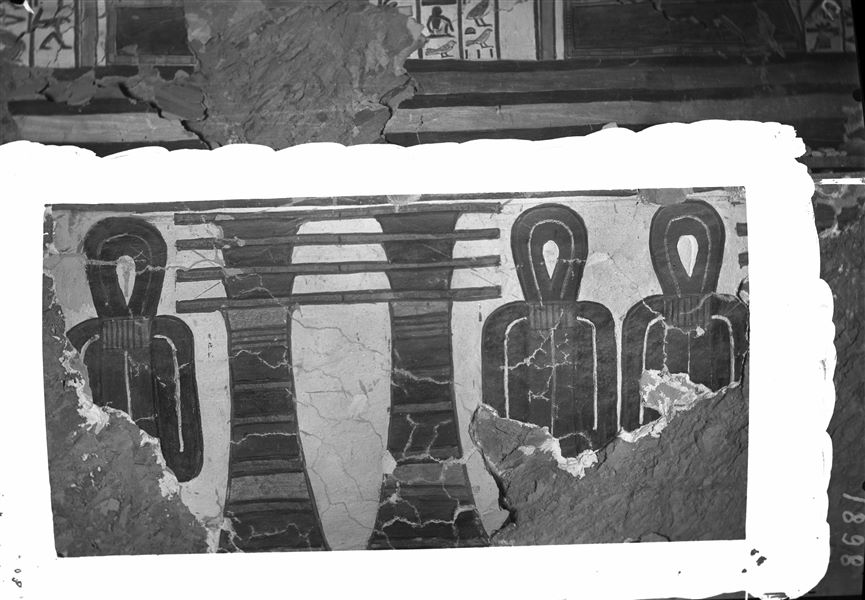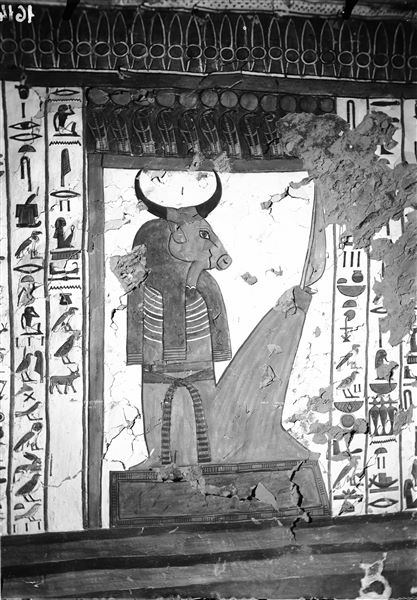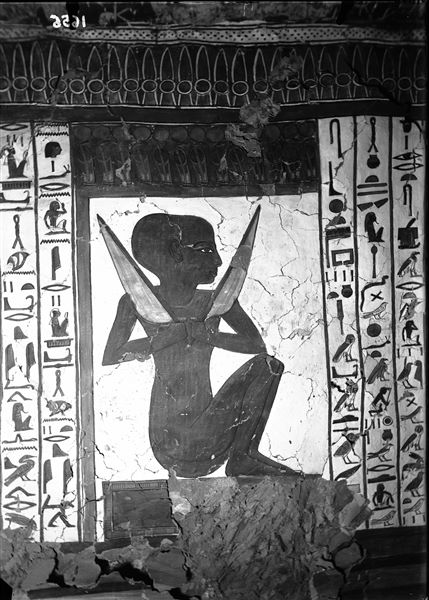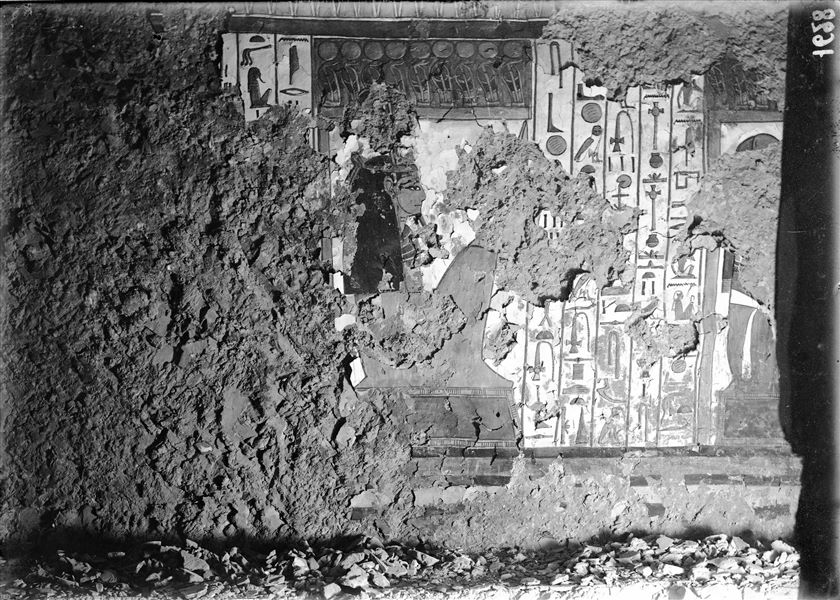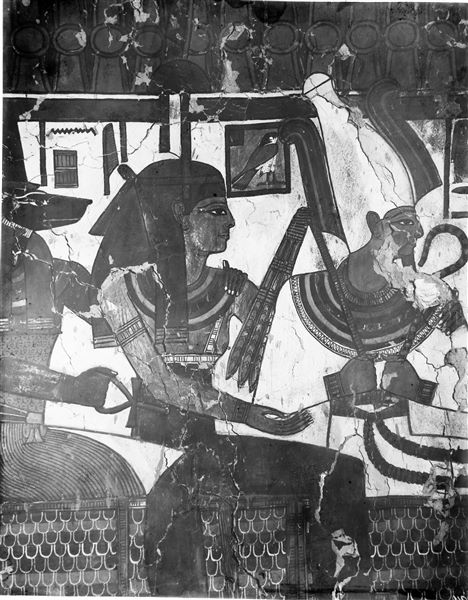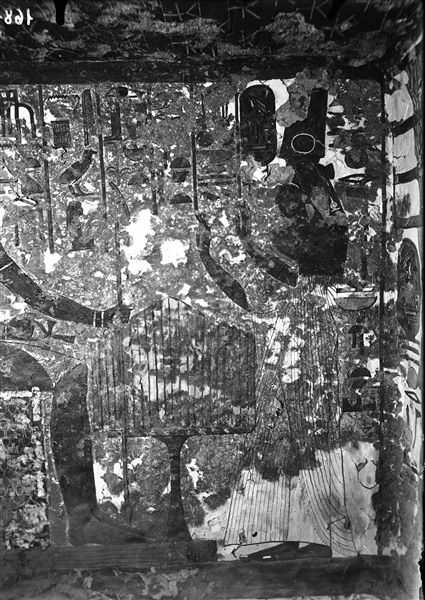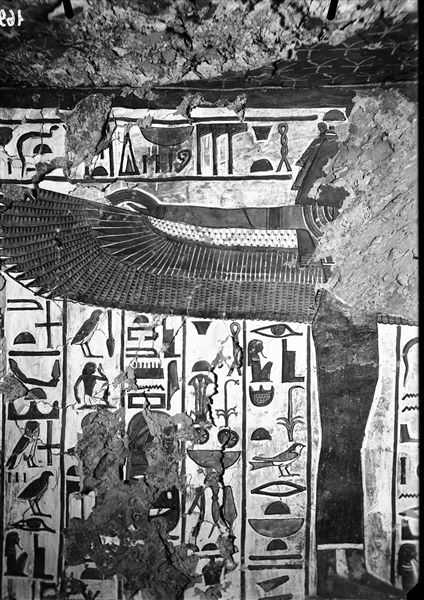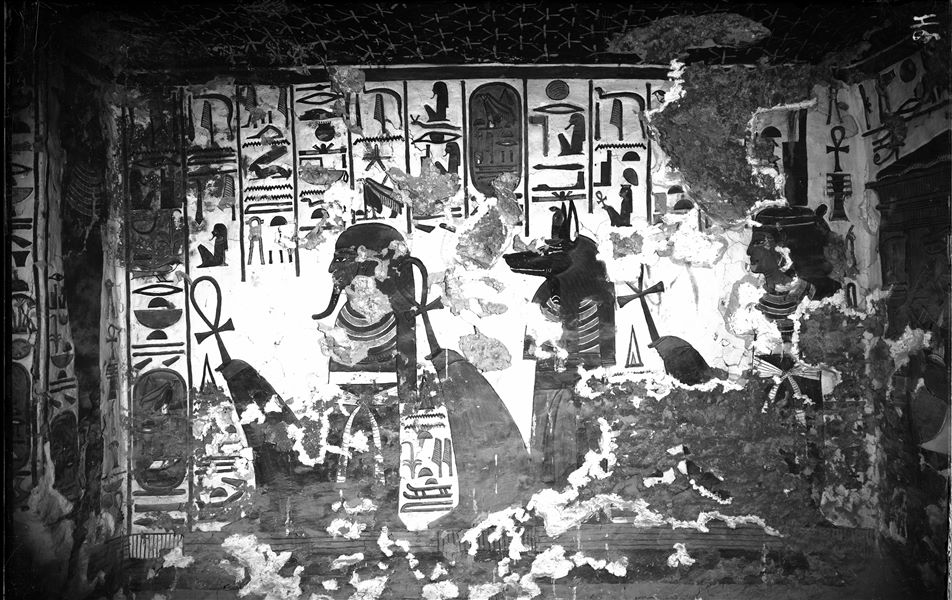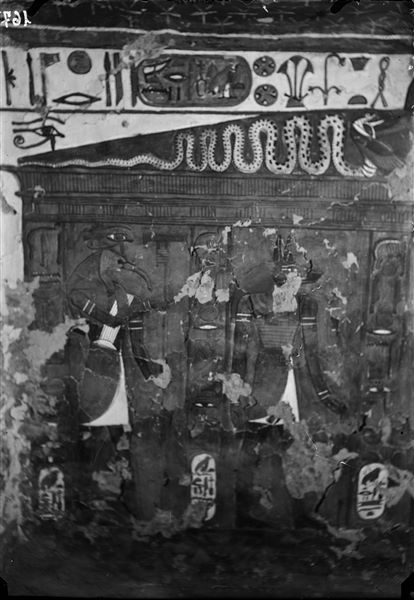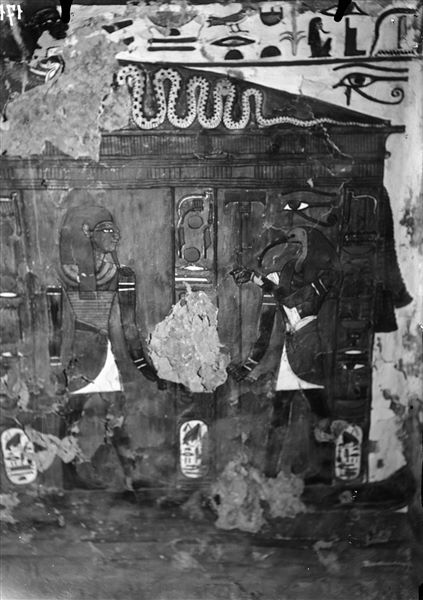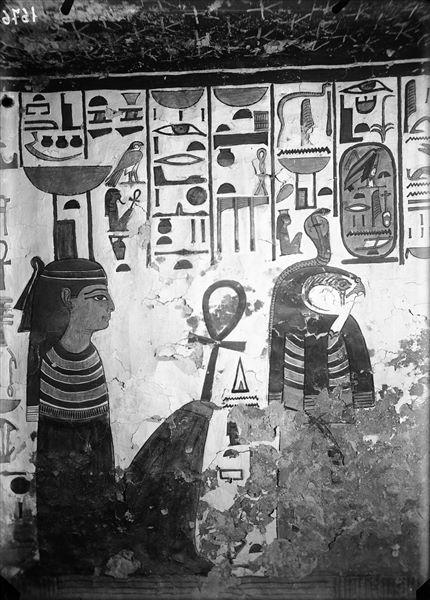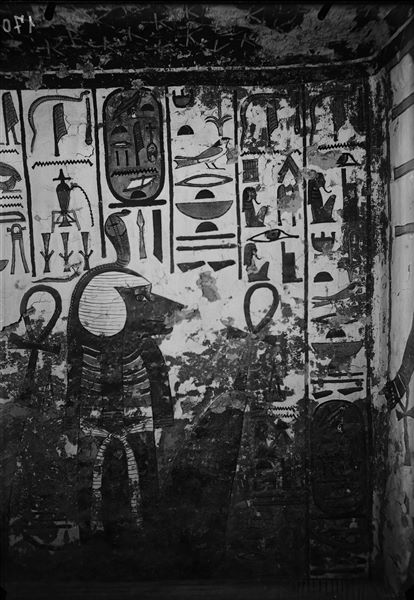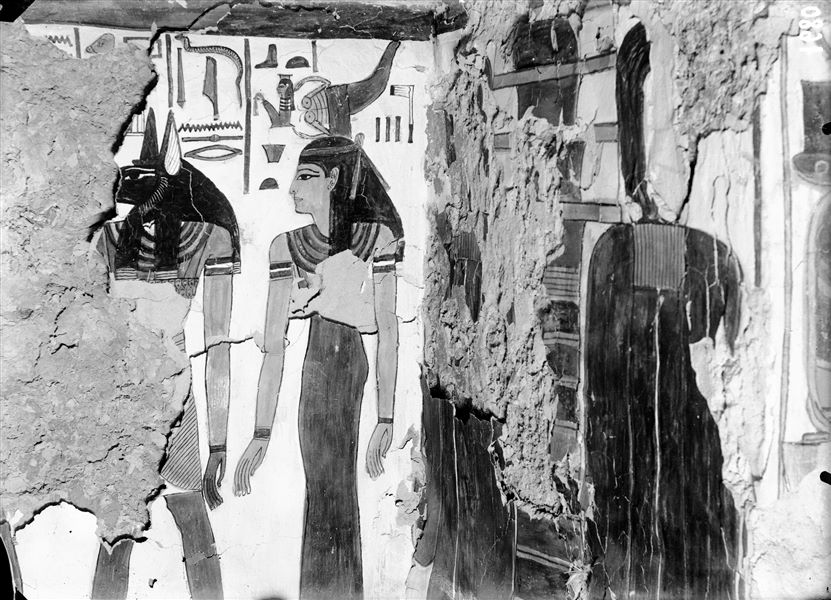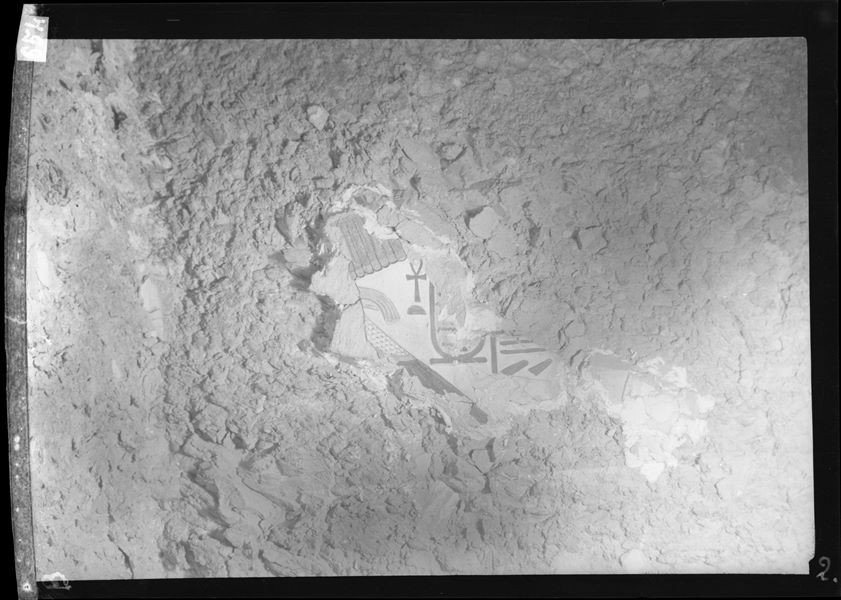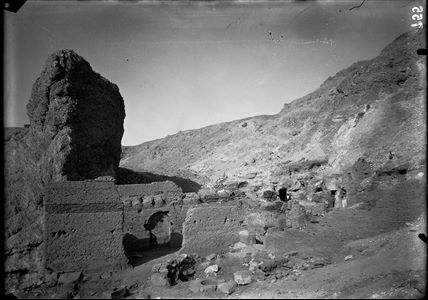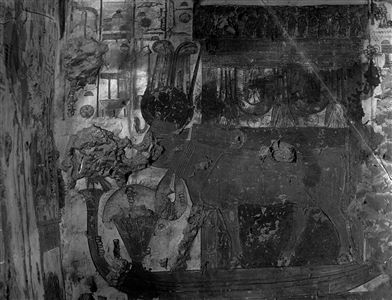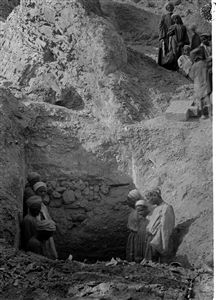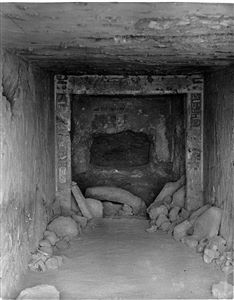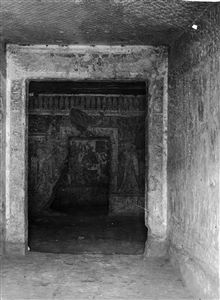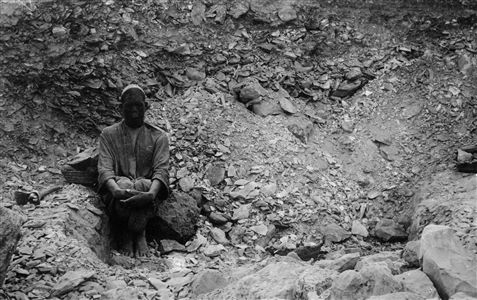Left side of the Valley. Excavations that led up to the discovery of the tomb of Nefertari (original label). Schiaparelli excavations.
Floorplan and longitudinal section of the tomb of Nefertari, drawn by Francesco Ballerini, scale 1:250.
View of the Valley of the Queens. In the centre the entrance (with a modern brick structure) to tomb of Queen Nefertari (QV66) is visible. Photograph taken from the bottom of the valley. The camp is visible in the background. Farina excavations.
Entrance to the tomb of Nefertari at the time of its discovery. Photographed from the descending steps. Schiaparelli excavations.
Entrance to the tomb of Nefertari (QV66) at the time of its discovery. Photographed from the descending steps. Schiaparelli excavations.
Entrance to tomb of Nefertari (QV66), with a modern brick structure covering the descending staircase. In the foreground, there are some people, among which could include Howard Carter. They are testing a power generator in order to illuminate the tomb. Schiaparelli or Farina excavations.
Entrance to the tomb of Nefertari, with a modern brick structure covering the descending staircase. Schiaparelli or Farina excavations.
Entrance to the tomb of Nefertari (QV66), with a modern brick structure covering the descending staircase. A commemorative plaque of the discovery (of the tomb) during the Italian excavations is visible. Schiaparelli excavations.
Interior of the tomb of Nefertari, antechamber, south-east wall, scene 2: the queen is depicted playing senet, her Ba is on a small temple, followed by the queen (once again) in the act of adoration. In the centre, Spell 17 of the Book of the Dead. The lower register shows a decoration composed of Djed pillars and Tit knots. The presence of debris is also visible on a shelf carved out from the rock.
Interior of the tomb of Nefertari, antechamber, scene 2: the queen is depicted playing senet, her Ba is on a small temple, followed by the queen (once again) in the act of adoration. In the centre, Spell 17 of the Book of the Dead. The lower register shows a decoration composed of Djed pillars and Tit knots. The presence of debris is visible on a shelf carved out from the rock.
Interior of the tomb of Nefertari, antechamber, scene 2: the queen is depicted playing senet, her Ba is on a small temple, followed by the queen (once again) in the act of adoration. In the centre, Spell 17 of the Book of the Dead. The lower register shows a decoration composed of Djed pillars and Tit knots.
Interior of the tomb of Nefertari, antechamber, scene 2: the queen is depicted playing senet, her Ba is on a small temple, followed by the queen (once again) in the act of adoration. In the centre, Spell 17 of the Book of the Dead. The lower register shows a decoration composed of Djed pillars and Tit knots. Photographic plate in positive.
Interior of the tomb of Nefertari, antechamber, scene 2: lower register decorated with two painted Djed pillars and two Tit knots.
Interior of the tomb of Nefertari, antechamber, scene 2: upper register representing the queen playing senet, her Ba on a small temple and the queen (again) in the act of adoration.
Interior of the tomb of Nefertari, antechamber, scene 2: upper register representing the queen playing senet, her Ba on a small temple and the queen (again) in the act of adoration. Also visible is the ceiling painted with stars.
Interior of the tomb of Nefertari, antechamber, scene 2: upper register representing the queen playing senet, her Ba on a small temple and the queen (again) in the act of adoration. Also visible is the ceiling painted with stars.
Detail from scene 2: upper register representing the Ba on a small temple and Nefertari in the act of adoration.
Interior of the tomb of Nefertari, antechamber, scene 2: upper register representing the queen playing senet, her Ba on a small temple and the queen (again) in the act of adoration.
Interior of the tomb of Nefertari (QV66), antechamber, scene 2: upper register representing the queen playing senet, her Ba on a small temple and the queen (again) in the act of adoration. Also visible is the ceiling painted with stars.
View of the antechamber, south-west and west walls, scenes 2 and 3. In the upper register, scene 2 shows the queen playing senet, her Ba on a small temple, and the queen (again) in an act of adoration. Scene 3 presents Atum between two lions, the Benu bird, the mummy (of Nefertari) on a bed between two falcons which represent the goddesses Nephtys and Isis, and the god of the Nile on his knees. The central register presents Spell 17 of the Book of the Dead. Below, represented on the left is a decoration composed of Djed pillars and Tit knots, while in the centre there is a cavetto cornice with representations of sanctuaries. Also visible is the ceiling painted with stars.
View of the antechamber, scenes 2 and 3. In the upper register, scene 2 shows the queen playing senet, her Ba on a small temple, and the queen (again) in an act of adoration. Scene 3 presents Atum between two lions, the Benu bird, the mummy (of Nefertari) on a bed between two falcons which represent the goddesses Nephtys and Isis, and the god of the Nile on his knees. The central register presents Spell 17 of the Book of the Dead. Below, represented on the left is a decoration composed of Djed pillars and Tit knots, while in the centre there is a cavetto cornice, with representations of sanctuaries. Also visible is the ceiling painted with stars.
View of the antechamber, west wall, scene 3. Represented in the upper register: Atum between two lions, the Benu bird, the mummy (of Nefertari) on a bed between two falcons which represent the goddesses Nephtys and Isis. These are representations connected with the central register, which presents Spell 17 of the Book of the Dead. Below, represented on the left is a decoration composed of Djed pillars and Tit knots, while in the centre there is a cavetto cornice, with representations of sanctuaries. The presence of wall fragments on the shelf and debris on the floor could suggest that the photograph was taken shortly after the discovery of the tomb.
View of the antechamber, west wall, scene 3. Represented in the upper register: Atum between two lions, the Benu bird, the mummy (of Nefertari) on a bed between two falcons which represent the goddesses Nephtys and Isis. These are representations connected with the central register, which presents Spell 17 of the Book of the Dead. Below, represented on the left are Djed pillars and Tit knots, while in the centre there is a cavetto cornice, with representations of sanctuaries. Also visible is the ceiling painted with stars.
View of the antechamber, west wall, scene 3. Represented in the upper register: Atum between two lions, the Benu bird, the mummy (of Nefertari) on a bed between two falcons which represent the goddesses Nephtys and Isis. These are representations connected with the central register, which presents Spell 17 of the Book of the Dead. Below, represented on the left is a decoration composed of Djed pillars and Tit knots, while in the centre there is a cavetto cornice, with representations of sanctuaries. Also visible is the ceiling painted with stars.
View of the antechamber, west wall, scene 3. Represented in the upper register: Atum between two lions, the Benu bird, the mummy (of Nefertari) on a bed between two falcons which represent the goddesses Nephtys and Isis. These are representations connected with the central register, which presents Spell 17 of the Book of the Dead. Below, represented on the left is a decoration composed of Djed pillars and Tit knots, while in the centre there is a cavetto cornice, with representations of sanctuaries. Also visible is the ceiling painted with stars.
View of the antechamber, west wall, scene 3. Represented in the upper register: Atum between two lions, the Benu bird, the mummy (of Nefertari) on a bed between two falcons which represent the goddesses Nephtys and Isis. These are representations connected with the central register, which presents Spell 17 of the Book of the Dead. Below, represented on the left is a decoration composed of Djed pillars and Tit knots, while in the centre there is a cavetto cornice, with representations of sanctuaries. Also visible is the ceiling painted with stars.
View of the antechamber, west wall, scene 3. Represented in the upper register: Atum between two lions, the Benu bird, the mummy (of Nefertari) on a bed between two falcons which represent the goddesses Nephtys and Isis. These are representations connected with the central register, which presents Spell 17 of the Book of the Dead. Below, represented on the left is a decoration composed of Djed pillars and Tit knots, while in the centre there is a cavetto cornice, with representations of sanctuaries. Also visible is the ceiling painted with stars.
View of the antechamber, west wall, scene 3. Represented in the upper register: Atum between two lions, the Benu bird, the mummy (of Nefertari) on a bed between two falcons which represent the goddesses Nephtys and Isis. These are representations connected with the central register, which presents Spell 17 of the Book of the Dead. Below, represented on the left is a decoration composed of Djed pillars and Tit knots, while in the centre there is a cavetto cornice, with representations of sanctuaries. Also visible is the ceiling painted with stars.
View of the antechamber, west wall, scene 3. Represented in the upper register: Atum between two lions, the Benu bird, the mummy (of Nefertari) on a bed between two falcons which represent the goddesses Nephtys and Isis. These are representations connected with the central register, which presents Spell 17 of the Book of the Dead. Below, represented on the left is a decoration composed of Djed pillars and Tit knots, while in the centre there is a cavetto cornice, with representations of sanctuaries. Also visible is the ceiling painted with stars.
Detail of the central part of scene 3, showing a sarcophagus between two falcons representing the goddesses Nephtys and Isis. Several wall fragments can be seen on the shelf.
View of the antechamber, west wall, scene 3, from the tomb of Queen Nefertari (QV66). Schiaparelli excavations.
Photograph taken inside the tomb of Queen Nefertari (QV66). West wall of the antechamber, upper register, scene 3. The mummy of the Queen is placed on a bed between two falcons, representing the goddesses Nephtys and Isis. On the left, there is the Benu bird, symbol of the incarnation of Ra’s soul. Angelo Sesana Archive.
View of the antechamber’s west wall, photographed from the first eastern annexe (alcove), east (right) of the antechamber.
View of the antechamber, north wall, scene 4. The central register shows Spell 17 of the Book of the Dead, while in the part below, the end of the cavetto cornice with representations of sanctuaries can be seen. The presence of wall fragments on the shelf may suggest that the photograph was taken shortly after the discovery of the tomb.
View of the antechamber, north wall, scene 4. In the upper register (from the left): the celestial cow, a canopic chest with the animal representation of the god Anubis; by his sides are the four sons of Horus in pairs. Two seated figures follow the scene, possibly the gods Re and Shu. The central register shows Spell 17 of the Book of the Dead.
View of the antechamber, north wall, scene 4. In the upper register (from the left): the celestial cow, a canopic chest with the animal representation of the god Anubis; by his sides are the four sons of Horus in pairs. Two seated figures follow the scene, possibly the gods Re and Shu. The two figures facing right are Horus and Qebehsenuef forming part of scene 19. The central register shows Spell 17 of the Book of the Dead.
View of the antechamber, north wall, scenes 4 and 19. From the north wall there is access to the descending corridor leading to the burial chamber. Above the access, scene 19 with the representation of the god Horus and the four sons of Horus (funerary deities): from the right Imseti, Hapy, Duamutef, and Qebehsenuef.
Photograph taken inside the tomb of Queen Nefertari (QV66). North wall of the antechamber, upper register, scene 4. Anubis is depicted crouching in front of a canopic chest or shrine, with the four sons of Horus standing on either side. Angelo Sesana Archive.
View of the antechamber, north wall, scene 19. From the north wall there is access to the descending corridor leading to the burial chamber. Above the access, scene 19 with the representation of the god Horus and the four sons of Horus (funerary deities): from the right Imseti, Hapy, Duamutef, and Qebehsenuef.
View of scene 19, lintel above the access to the descending corridor leading to the burial chamber. The four sons of Horus, from the right: Imseti, Hapy, Duamutef, Qebehsenuef.
View of the antechamber, north wall. Wall decoration (scene 11), east of the access to the descending corridor leading to the burial chamber, with the god Osiris facing the vestibule.
View of the north-east corner of the antechamber, showing access to the descending corridor leading to the burial chamber.
View of scene 19, lintel above the access to the descending corridor leading to the burial chamber. The four sons of Horus, from the right: Imseti, Hapy, Duamutef, Qebehsenuef. On the right, scene 11 representing the god Osiris and the goddess Selkis.
Panoramic view from the antechamber, north wall in the direction of the descending corridor. At the end of the corridor the burial chamber can be seen.
Wall decoration, scene 11, east of the access to the descending corridor leading to the burial chamber, with the god Osiris facing the vestibule.
Wall decoration, scene 11, east of the access to the descending corridor leading to the burial chamber, with the god Osiris facing the vestibule.
Wall decoration of the antechamber, east wall, south side, scene 6, with the god Anubis facing the entrance to the tomb.
Wall decoration of the antechamber, east wall, south side, scene 6, with the god Anubis facing the entrance to the tomb.
View of the south-east corner of the antechamber. On the right, the entrance to the tomb, on the left, the access to the vestibule and the first eastern annex (alcove). In addition to the god Anubis on the east wall, south side; visible on the south wall, east side is the god Osiris seated, and Nefertari in the act of worship. Osiris and Anubis are inside a sanctuary.
Photograph of a recomposition of images relating to the south-east and south walls of the antechamber A, scenes 5 and 6, showing the gods Anubis and Osiris, inside a sanctuary.
South wall, east side of the antechamber, scene 5. Osiris seated inside a sanctuary, surmounted by a frieze of uraei with sun disks. On the right, Nefertari in the act of adoration.
South wall, east side of the antechamber, scene 5. Osiris seated inside a sanctuary, surmounted by a frieze of uraeus-serpents with sun disks. On the right, Nefertari in the act of adoration.
South wall, east side of the antechamber, scene 5. Osiris seated inside a sanctuary, surmounted by a frieze of uraei with sun disks. On the right, Nefertari in the act of adoration. The stairs to the entrance of the tomb are visible.
South wall, east side of the antechamber, scene 5. Osiris seated inside a sanctuary, surmounted by a frieze of uraei with sun disks. On the right, Nefertari in the act of adoration. The stairs to the entrance of the tomb are visible.
Lintel of the access to the vestibule from the antechamber, decorated with eleven uraeus-serpents alternating with eleven blue ostrich feathers. In the centre a kneeling deity.
View of scene 6, which gives access to the vestibule. The goddess Neith can be seen looking towards the antechamber.
View of scene 6, which gives access to the vestibule. The goddess Neith can be seen looking towards the antechamber.
View of scene 6, which gives access to the vestibule. The goddess Neith can be seen looking towards the antechamber.
South-west corner of the vestibule, scenes 6 and 7. On the right: the goddess Neith facing the vestibule (scene 6). In the centre on the west wall, south side: the representation of the god Osiris with his head in the form of a Djed pillar with the Atef crown. On the left, south wall: the god Horus with the double crown or Pschent leads Nefertari by the hand (scene 7).
South wall of the vestibule, scene 7. The god Horus wearing a double crown or Pschent leads Nefertari by the hand.
South wall of the vestibule, scene 7. The god Horus wearing a double crown or Pschent leads Nefertari by the hand.
Detail of the south wall of the vestibule, scene 7. The god Horus wearing a double crown or Pschent leads Nefertari by the hand.
South wall of the vestibule, scene 7. The god Horus wearing a double crown or Pschent leads Nefertari by the hand.
View of the vestibule, in the direction of the first eastern annex (alcove). Particularly visible is the south-east corner, scenes 7 and 8 .The god Horus leads Nefertari (not visible here, scene 7) towards two seated gods, Re-Horakhty and Hathor (scene 8). On the right, corresponding to the entrance of the vestibule, the goddess Neith is visible (scene 6) looking towards the antechamber. In the foreground, the lintel of the entrance to the vestibule is decorated with eleven uraeus-serpents alternating with eleven blue ostrich feathers and a kneeling deity in the centre. Photograph taken from the antechamber.
View of the east wall of the vestibule, from which there is access to the first eastern annex (alcove). From this area, the back wall of the vestibule can be seen. On the south side (right) of the wall, the gods Re-Horakhty and Hathor are seated (scene 8). On the north side (left), the god Khepri is visible (scene 9). Above the access to the first eastern annex is the goddess Nekhbet in her animal form as a vulture.
View of the east wall of the vestibule, from which there is access to the first eastern annex (alcove). From this area, the back wall of the vestibule can be seen. On the south side (right) of the wall, the gods Re-Horakhty and Hathor are seated (scene 8). On the north side (left), the god Khepri is visible (scene 9). Above the access to the first eastern annex is the goddess Nekhbet in her animal form as a vulture.
East wall of the vestibule, south side, scene 8. The gods Re-Horakhty and Hathor are depicted seated.
Detail of the east wall of the vestibule, south side, scene 8: Re-Horakhty and Hathor.
Vestibule, north-east corner, scenes 9 and 10. The goddess Isis accompanies Nefertari (not visible in this photograph) towards the god Khepri who is represented on the east wall, north side of the vestibule. On the right is the access to the first eastern annex (alcove).
Vestibule, north-east corner, scenes 9 and 10. The goddess Isis accompanies Nefertari (not visible in this photograph) towards the god Khepri who is represented on the east wall, north side of the vestibule. On the right is the access to the first eastern annex (alcove).
Vestibule, north-east corner, scenes 9 and 10. The goddess Isis accompanies Nefertari (not visible in this photograph) towards the god Khepri who is represented on the east wall, north side of the vestibule. In the centre is the access to the first eastern annex (alcove). The identity of the draughtsman photographed here is not known for certain.
Vestibule, north-east corner, scenes 9 and 10. The goddess Isis accompanies Nefertari (not visible in this photograph) towards the god Khepri who is represented on the east wall, north side of the vestibule. In the centre is the access to the first eastern annex (alcove). The identity of the draughtsman photographed here is not known for certain.
Vestibule, north wall, scene 10. The goddess Isis (on the right) accompanies Nefertari (left) towards the god Khepri; represented on the wall beside them.
Vestibule, north wall, scene 10. The goddess Isis (on the right) accompanies Nefertari (left) towards the god Khepri; represented on the wall beside them.
Vestibule, north wall, scene 10. The goddess Isis (on the right) accompanies Nefertari (left) towards the god Khepri; represented on the wall beside them.
Vestibule, north wall, scene 10. Detail of the two figures, the goddess Isis on the right and Nefertari on the left.
Vestibule, north wall, scene 10. Detail of the figure of Nefertari.
View of scene 11, which gives access to the vestibule. The goddess Selkis can be seen, looking towards the antechamber.
View of scene 11, giving access to the vestibule. The goddess Selkis can be seen, looking towards the antechamber.
View of the vestibule and in the background; the antechamber, photographed from the first eastern annex (alcove). In the foreground, scene 12 is visible, between the two rooms, the goddess Maat can be seen. In the background, scene 11 represents the goddess Selkis.
View of the vestibule and in the background; the antechamber, photographed from the first eastern annex (alcove). In the foreground, scene 12 is visible between the two rooms. On the north side, the goddess Maat can be seen. In the background, scene 11 represents the goddess Selkis.
First eastern annex (alcove), west wall, north side, scene 13. Nefertari is represented in the act of making a linen offering to the god Ptah (not visible in this photograph).
First eastern annex (alcove), west wall, north side, scene 13. Nefertari is represented in the act of making a linen offering to the god Ptah (not visible in this photograph).
First eastern annex (alcove), west wall, north side, scene 13. The god Ptah is depicted inside a sanctuary, in the act of receiving a linen offering from Nefertari (not visible in this photograph).
First eastern annex (alcove), west wall, north side, scene 13. The god Ptah is depicted inside a sanctuary, in the act of receiving a linen offering from Nefertari (not visible in this photograph).
First eastern annex (alcove), west wall, north side, scene 13. The god Ptah is depicted inside a sanctuary, in the act of receiving a linen offering from Nefertari (not visible in this photograph).
First eastern annexe (alcove), west wall, north side, detail of scene 13. Face of the god Ptah depicted inside a sanctuary (not visible here), in the act of receiving a linen offering from Nefertari.
First eastern annex (alcove), north wall, scene 14. Nefertari is represented in front of the seated god Thoth. Between them is a container with scribal implements and a magical object in the form of a frog. Behind Nefertari, the initial part of Spell 94 of the Book of the Dead is visible.
First eastern annex (alcove), west wall, south side, scene 15. A mummiform deity with a ram's head and sun disk - reminiscent of the characteristics of Osiris and Re - is assisted by the goddesses Nephtys (left) and Isis (right).
First eastern annex (alcove), west wall, south side, scene 15. A mummiform deity with a ram's head and sun disk - reminiscent of the characteristics of Osiris and Re - is assisted by the goddesses Nephtys (left) and Isis (right).
First eastern annex (alcove), west wall, south side, scene 15. A mummiform deity with a ram's head and sun disk - reminiscent of the characteristics of Osiris and Re - is assisted by the goddesses Nephtys (left) and Isis (right).
First eastern annex (alcove), west wall, south side, scene 15. A mummiform deity with a ram's head and sun disc - reminiscent of the characteristics of Osiris and Re - is assisted by the goddesses Nephtys (left) and Isis (right).
First eastern annex (alcove), west wall, south side, scenes 15 and 16. On the south (left), Nefertari is in the act of reciting an invocation from Spell 148 of the Book of the Dead. On the north (right), part of scene 15 shows the goddess Nephtys in the act of assisting a mummiform deity with a ram's head and solar disk; characteristics of Osiris and Ra.
South-west corner of the first eastern annexe (alcove). The west wall, south side, shows scene 16 with the representation of Nefertari. The south wall (left, scene 17) shows three registers with Spell 148 of the Book of the Dead. Each of the animals has an altar with food offerings in front of it for the nourishment of Nefertari. The lower register shows four helms, used by the queen during her journey among the stars.
First eastern annexe (alcove), west wall, south side, scene 16. Nefertari is presumably represented in the act of reciting an invocation from Spell 148 of the Book of the Dead, which is depicted on the next wall (the south wall, left, scene 17).
First eastern annexe (alcove), west wall, south side, scene 16. Detail of queen Nefertari in the act of reciting an invocation from Spell 148 of the Book of the Dead, which is depicted on the adjacent wall (south wall, left, scene 17).
First eastern annexe (alcove), west wall, south side, scene 16. Detail of queen Nefertari in the act of reciting an invocation from Spell 148 of the Book of the Dead, which is depicted on the adjacent wall (south wall, left, scene 17).
South-east corner of the first eastern annex, where parts of scenes 17 and 18 are visible. The south wall (scene 17) shows Spell 148 of the Book of the Dead, with a series of seven cows and a bull in the central register. The east wall (scene 18) shows Nefertari with the Sekhem sceptre, in the act of making offerings to honour the god Atum, not visible here.
First eastern annexe (alcove), south wall, scene 17. On two registers there are seven cows and a bull, representations from Spell 148 of the Book of the Dead. Each of the animals has an altar with food offerings in front of it, for the nourishment of Nefertari. The lower register shows four helms, used by the queen during her journey among the stars; this too is a representation from Spell 148 of the Book of the Dead.
First eastern annexe (alcove), south wall, scene 17. On two registers there are seven cows and a bull, representations from Spell 148 of the Book of the Dead. Each of the animals has an altar with food offerings in front of it, for the nourishment of Nefertari. The lower register shows four helms, used by the queen during her journey among the stars; this too is a representation from Spell 148 of the Book of the Dead.
South-west corner of the first eastern annex (alcove). The west wall, south side, shows scene 16, with a representation of Nefertari. The south wall (left, scene 17) shows three registers with Spell 148 of the Book of the Dead. Each of the animals has an altar with food offerings in front of it, for the nourishment of Nefertari. The lower register shows four helms, used by the queen during her journey among the stars.
First eastern annexe (alcove), east wall, scene 18. The left side of the wall shows Nefertari with the Sekhem sceptre. She is in the act of presenting offerings to honour the god Osiris, not visible here.
First eastern annexe (alcove), east wall, scene 18. The left side of the wall shows Nefertari with the Sekhem sceptre. She is in the act of presenting offerings to honour the god Osiris, not visible here.
First eastern annexe (alcove), east wall, scene 18. Detail of the pile of offerings shown between Nefertari and the seated god Osiris. The inscription above shows in one part, Nefertari's invocation with offerings to the god, in the other, the god responds by making promises in return.
First eastern annex (alcove), east wall, scene 18. Detail of the pile of offerings shown between Nefertari and the seated god Osiris. The inscription above shows in one part, Nefertari's invocation with offerings to the god, in the other, the god's benevolent reply.
First eastern annex (alcove), east wall, scene 18. Detail of the god Osiris seated and facing north (left), in the act of receiving offerings from Nefertari, not visible here.
First eastern annex (alcove), east wall, scene 18. Representation of the central area of the wall, where two deities are seated; on one side Osiris, on the other Atum. They are positioned symmetrically and receive a pile of offerings from Nefertari. Neither Nefertari or the offering pile are visible here.
First eastern annex (alcove), east wall, scene 18. Representation of the central area of the wall, where two deities are seated; on one side Osiris, on the other Atum. They are positioned symmetrically and receive a pile of offerings from Nefertari. Neither Nefertari or the offering pile are visible here.
First eastern annex (alcove), east wall, scene 18. Representation of the central area of the wall, where two deities are seated; on one side Osiris, on the other Atum. They are positioned symmetrically and receive a pile of offerings from Nefertari. Neither Nefertari or the offering pile are visible here.
First eastern annexe (alcove), east wall, scene 18. Detail of the god Atum seated and facing south (right), in the act of receiving offerings from Nefertari, not visible here.
First eastern annex (alcove), east wall, scene 18. Detail of the pile of offerings shown between Nefertari and the seated god Atum. The inscription above shows in one part, Nefertari's invocation with offerings to the god, in the other, the god's benevolent reply.
First eastern annex (alcove), east wall, scene 18. Detail of the pile of offerings shown between Nefertari and the seated god Atum. The inscription above shows in one part, Nefertari's invocation with offerings to the god, in the other, the god's benevolent reply.
First eastern annex (alcove), east wall, scene 18. Detail of the pile of offerings shown between Nefertari and the seated god Atum. The inscription above shows in one part, Nefertari's invocation with offerings to the god, in the other, the god's benevolent reply.
First eastern annexe (alcove), east wall, scene 18. Detail of the right side of the wall. Nefertari is depicted with the Sekhem sceptre. She is in the act of presenting offerings to honour the god Atum, not visible here.
Descending corridor, east wall, scene 20. The goddess Neith is represented, facing towards the entrance of the descending corridor. To the right, in darkness, is the antechamber.
Descending corridor, east wall, scene 27. On the left, the goddess Maat (scene 28, depicted on the right side of the access to the burial chamber), on the right, the goddess Nephtys is kneeling. Visible in the upper register is the god Anubis in his animal form, above a shrine. The inscriptions shown are benevolent expressions uttered by the two deities to Nefertari.
Descending corridor, east wall, scene 27. Detail of the goddess Nephtys kneeling. The inscriptions shown, which are partially damaged, are benevolent expressions uttered by the deity to Nefertari.
Descending corridor, east wall, scene 23. At the top of the descending corridor, there is a series of deities in the act of receiving offerings from Nefertari. Here she is seen holding two small jars in her hands in front of an offering table.
Descending corridor, east wall, scene 23. At the top of the descending corridor are a series of deities receiving offerings from Nefertari. The first deity, occupying the portion of the wall that follows the descent of the room, is the winged goddess Maat shown kneeling.
Descending corridor, scene 28, east side of the access to the burial chamber. A serpent with a double crown or Pschent, identified with Wadjet who represents Lower Egypt, is depicted on a basket resting on two Djed pillars. The goddess is facing the corridor.
Descending corridor, scene 28, east side of the access to the burial chamber. A serpent with a double crown or Pschent, identified with Wadjet who represents Lower Egypt, is depicted on a basket resting on two Djed pillars. The goddess is facing the corridor.
Descending corridor, scene 28, east side of the access to the burial chamber. The goddess Maat is depicted, next to the serpent symbolising the goddess Wadjet. Both deities are facing the stairs of the corridor.
The winged goddess Maat is shown kneeling, depicted on the lintel of the entrance to the burial chamber (scene 28). She is facing east (right).
The winged goddess Maat is shown kneeling, depicted on the lintel of the entrance to the burial chamber (scene 28). She is facing east (right). The ceiling, like the rest of the tomb, is painted with stars.
The winged goddess Maat is shown kneeling, depicted on the lintel of the entrance to the burial chamber (scene 28). She is facing east (right). The ceiling, like the rest of the tomb, is painted with stars.
The winged goddess Maat is shown kneeling, depicted on the lintel of the entrance to the burial chamber (scene 28). She is facing east (right). The ceiling, like the rest of the tomb, is painted with stars.

Descending corridor, right side, from the tomb of Queen Nefertari (QV66). The corridor has hieroglyphic inscriptions, some of which are no longer visible today, photographed from above. Schiaparelli excavations.

Access to the descending corridor, from the antechamber of the tomb of Queen Nefertari (QV66). The corridor already shows the presence of a wooden support used as a handrail for descending and ascending within the tomb. Schiaparelli excavations.

Descending corridor, right side, from the tomb of Queen Nefertari (QV66). The corridor has hieroglyphic inscriptions, some of which are no longer visible today, photographed from above. Schiaparelli excavations.
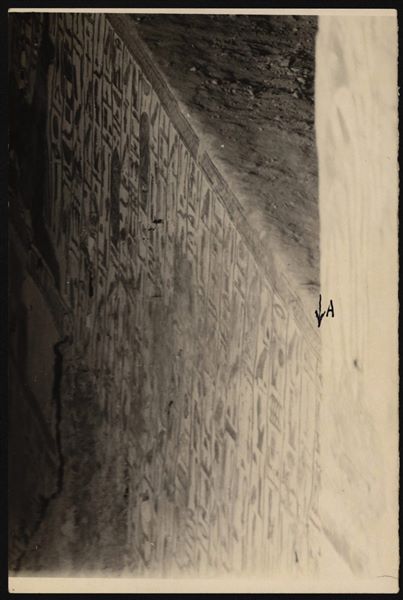
Descending corridor, right side, from the tomb of Queen Nefertari (QV66). The corridor has hieroglyphic inscriptions, some of which are no longer visible today, photographed from above. Schiaparelli excavations.
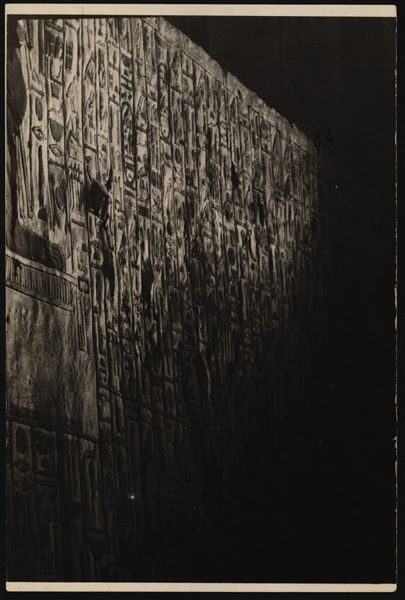
Descending corridor, right side, from the tomb of Queen Nefertari (QV66). The corridor has hieroglyphic inscriptions, some of which are no longer visible today, photographed from above. Schiaparelli excavations.
Descending corridor, west wall, scene 26. On the right, the goddess Maat (scene 28, depicted on the left side of the access to the burial chamber), on the left, shown kneeling is the goddess Isis. In the upper register, the god Anubis in his animal form, is on top of a shrine. The inscriptions are benevolent expressions uttered by the two deities to Nefertari.
Descending corridor, west wall, scene 26. Detail of the goddess Isis kneeling above a representation of the hieroglyph Nbw meaning 'gold'. Her hands are resting on another hieroglyphic symbol, the Shen-sign.
Descending corridor, west wall, scene 26. Central register, detail of the god Anubis resting on a shrine. The god is facing the antechamber. The inscriptions are benevolent expressions uttered by the god to Nefertari.
Descending corridor, west wall, scene 26. Upper register, detail of a winged serpent facing the cartouche of Nefertari, in the direction of the antechamber. Also visible is the ceiling painted with stars.
Descending corridor, west wall, scene 22. At the top of the descending corridor, there are three deities in the act of receiving offerings from Nefertari. Here she is seen holding two small jars in her hands in front of an offering table.
Descending corridor, west wall, scene 22. At the top of the descending corridor, there are three deities that receive offerings from Nefertari. In this photograph the goddesses Isis and Nephtys are depicted seated and facing the queen.
Descending corridor, west wall, scene 22. At the top of the descending corridor are a series of deities receiving offerings from Nefertari. The last deity, occupying the portion of the wall that follows the descent of the room, is the winged goddess Maat shown kneeling.
View of the burial chamber, in the direction of the entrance corridor. On the right, the access to the western annexe is visible.
Cross-section view of the burial chamber, photographed from the western annexe. In addition to pillars A and C, visible at the back is the east wall of the Second Eastern Annexe.
View of the burial chamber. Visible in the foreground is pillar C, side b, with the representation of the god Osiris inside a sanctuary.
View of the burial chamber, in the direction of the entrance corridor. On the right, the access to the western annexe is visible.
View of pillar A, side a, from the burial chamber. The god/priest Iunmutef can be seen, wearing a leopard-skin robe, pointing his arm towards the central part of the chamber. The inscription is addressed to Osiris.
View of pillar A, side a, from the burial chamber. The god/priest Iunmutef can be seen, wearing a leopard-skin robe, pointing his arm towards the central part of the chamber. The inscription is addressed to Osiris.
View of pillar A, side b, from the burial chamber. The goddess Hathor and queen Nefertari are depicted.
View of pillar A, side c, from the burial chamber. A Djed pillar is depicted with the name and titles of Nefertari inscribed on it.
View of pillar A, side d, from the burial chamber. The god Osiris is represented, facing the access corridor to the chamber.
View of pillar C, side a, from the burial chamber. The god/priest Horendotes can be seen, wearing a leopard-skin robe, pointing his arm towards the central part of the chamber. The inscription is addressed to Osiris.
View of pillar C, side d, from the burial chamber. Queen Nefertari (left) and the goddess Isis can be seen holding hands.
View of pillar C, side d, from the burial chamber. Photograph not taken perfectly. Once more, queen Nefertari on the left, and the goddess Isis can be seen holding hands.
Photographic collage of three sides of two pillars from the burial chamber, from left: pillar A, side b (the goddess Hathor and Nefertari); pillar A, side d (the god Osiris inside a sanctuary); pillar C, side d (the goddess Isis and Nefertari).
View of pillar B, side b, from the burial chamber. Queen Nefertari on the right and the goddess Isis on the left can be seen holding hands.
View of pillar B, side c, from the burial chamber. Depicted holding hands: Queen Nefertari on the left and the goddess Hathor on the right, with the emblem representing the West on her head.
View of pillar B, side c, from the burial chamber. Depicted holding hands: Queen Nefertari on the left and the goddess Hathor on the right, with the emblem representing the West on her head.
Photographic collage of three sides of two pillars from the burial chamber, from left: pillar B, side b (the goddess Isis and Nefertari); pillar A, side c (a Djed pillar); pillar B, side c (the goddess Hathor and Nefertari).
Photograph not perfectly taken. Still recognisable however is the central part of the burial chamber, with the three steps leading up to the sarcophagus in the centre of the room, and pillar D, side a, showing a Djed pillar. In the foreground the presence of fragments and/or debris can be seen.
View of pillar D, side c, from the burial chamber. Queen Nefertari on the right and the goddess Isis on the left can be seen holding hands.
View of pillar D, side c, from the burial chamber. Queen Nefertari on the right and the goddess Isis on the left can be seen holding hands.
View of pillar D, side d, from the burial chamber. Queen Nefertari on the left and the god Anubis on the right can be seen.
Photographic collage of three sides of three different pillars from the burial chamber, from left: pillar A, side a (the god Iunmutef); pillar D, side d (the god Anubis and Nefertari); pillar C, side a (the god Horendotes).
Burial chamber, south wall, west side, scene 29. Nefertari is depicted in the act of adoration, facing west (right) in the direction of the first portal; three guardians are depicted on the same wall but not visible in this photograph. Spell 144 of the Book of the Dead begins on this wall.
Burial chamber, south wall, west side, scene 29. Nefertari is depicted in the act of adoration, facing west (right) in the direction of the first portal and three guardians who are depicted on the same wall but not visible in this photograph. Spell 144 of the Book of the Dead begins on this wall.
Burial chamber, south wall, west side, scene 29. Nefertari is depicted in the act of adoration, facing west (right) in the direction of the first portal and three guardians who are depicted on the same wall but not visible in this photograph. Spell 144 of the Book of the Dead begins on this wall.
Burial chamber, south-west corner, scene 29. The representation of Spell 144 of the Book of the Dead continues. The first portal, which Nefertari must pass through, can be seen as well as two of her guardians (the third is not visible here).
Burial chamber, south-west corner, scene 29. The representation of Spell 144 of the Book of the Dead continues. The first portal, which Nefertari must pass through, can be seen as well as two of her guardians (the third is not visible here).
Burial chamber, south-west corner, scene 29. The representation of Spell 144 of the Book of the Dead continues. The first portal, which Nefertari must pass through, can be seen as well as her guardians.
Burial chamber, south-west corner, scene 29. The three guardians can be seen guarding the first portal. On the right, the entrance to the western annexe is visible.
Burial chamber, south-west corner. Two of the three door-keepers guarding the first portal can be seen; the wall then displays (on the right) the continuation of Spell 144 of the Book of the Dead. In the centre, the entrance to the western annexe is visible.
Burial chamber, west wall, scene 30. The representation of Spell 144 of the Book of the Dead continues. The second portal, which Nefertari must pass through, can be seen as well as two of her guardians (the third is not visible here).
Burial chamber, west wall, scene 30. The representation of Spell 144 of the Book of the Dead continues. The second portal, which Nefertari must pass through, can be seen as well as two of her guardians (the third is not visible here).
Burial chamber, west wall, scene 30. The representation of Spell 144 of the Book of the Dead continues. The second portal, which Nefertari must pass through, can be seen as well as one of her guardians (the other two are not visible here).
Burial chamber, west wall, scene 30. The representation of Spell 144 of the Book of the Dead continues. The second portal, which Nefertari must pass through, can be seen as well as two of her guardians (the third is not visible here).
Burial chamber, west wall, scene 30. The three guardians of the second door, which Nefertari must pass through, are represented here.
Burial chamber, west wall, scene 30. The three guardians of the second door, which Nefertari must pass through, are represented here.
Two images superimposed, the first depicting the burial chamber, west wall, scene 30. The depiction of Spell 144 of the Book of the Dead continues, with two of the three guardians (the third is not visible here) of the second portal. On the right, the second image shows a detail of scene 30, where the third portal is depicted, together with three columns of text from Spell 144 of the Book of the Dead. In recent times part of the plaster from this wall has collapsed.
Burial chamber, west wall, scene 30. Two of the three guardians (the third is not visible here) of the second portal, which Nefertari must pass through, are depicted. There is also a continuation of the text from Spell 144 of the Book of the Dead. In recent times part of the plaster on this wall has collapsed.
Burial chamber, west wall, scene 30. The continuation of the text from Spell 144 of the Book of the Dead can be seen, followed by the third portal on the right. In recent times part of the plaster on this wall has collapsed.
Burial chamber, west wall, scene 30. Depiction of the third portal and one of the three guardians (the other two are not visible here). The left side of the portal was already in a fragile condition; in recent times, part of the plaster has collapsed.
Burial chamber, west wall, scene 30. This part of the wall is quite damaged, however two guardians of the third portal, which Nefertari has to pass through, can be recognised.
Burial chamber, west wall, scene 30. This part of the wall is quite damaged, however two guardians of the third portal, which Nefertari has to pass through, can be recognised.
Burial chamber, west wall, scene 30. This part of the wall is quite damaged, however two guardians of the third portal, which Nefertari has to pass through, can be recognised.
Burial chamber, west wall, scene 30. This part of the wall is quite damaged, however two guardians of the third portal, which Nefertari has to pass through, can be recognised.
Burial chamber, small niche in the middle of the west wall, scene 32. The image shows the south wall of the niche depicting three mummiform figures: Imseti, Anubis and Qebehsenuef. The back wall (left), shows the winged goddess Nut. (Pay attention that the photo was printed on the reverse side of the film)
Burial chamber, small niche in the middle of the west wall, scene 32. The image shows the north wall of the niche depicting three mummiform figures, probably Hapy, Anubis and Duamutef, here with the head of a falcon. In recent times, part of the plaster from this wall has collapsed. The back wall (left) shows the winged goddess Nut.
Burial chamber, north-west corner. Two guardians of the fourth portal are visible.
Burial chamber, north wall, scene 31. On the left, the three guardians of the fourth portal, which Nefertari must pass through, are visible. There is also a continuation of the text from Spell 144 of the Book of the Dead. In recent times, part of the plaster from this wall has collapsed.
Burial chamber, north wall, scene 31. On the left, the three guardians of the fourth portal, which Nefertari must pass through, are visible. There is also a continuation of the text from Spell 144 of the Book of the Dead. In recent times, part of the plaster from this wall has collapsed.
Burial chamber, north wall, scene 31. On the left, the three guardians of the fourth portal, which Nefertari must pass through, are visible. There is also a continuation of the text from Spell 144 of the Book of the Dead. In recent times, part of the plaster from this wall has collapsed.
Burial chamber, north wall, scene 31. The last portal is shown, as well as a guardian and the final part of Spell 144 of the Book of the Dead. On the right is the access to the north annex.
Burial chamber, north wall, scene 31. The last portal is shown, as well as a guardian and the final part of Spell 144 of the Book of the Dead. On the right is the access to the north annex.
Burial chamber, south wall, east side, scene 33. Nefertari is shown in the act of adoration, facing east (left), in the direction of the first gate, which (she) the queen must pass through. In front of her is the beginning of the text from Spell 146 of the Book of the Dead. On the right, the entrance corridor.
Burial chamber, south wall, east side, scene 33. Continuation of the text from Spell 146 of the Book of the Dead. The first gate and its vulture-headed guardian can be seen.
Burial chamber, south wall, east side, scene 33. Continuation of the text from Spell 146 of the Book of the Dead. The first two gates with their guardians can be seen.
Burial chamber, south wall, east side, scene 33. Continuation of the text from Spell 146 of the Book of the Dead. The second gate and its lion-headed guardian can be seen.
Burial chamber, east wall, scene 34. Continuation of the text from Spell 146 of the Book of the Dead. The third gate and its crocodile-headed guardian can be seen. In the centre, the entrance to the second eastern annex is visible.
Burial chamber, east wall, scene 34. Continuation of the text from Spell 146 of the Book of the Dead. The third gate and its crocodile-headed guardian can be seen.
Burial chamber, east wall, wall decoration consisting of pairs of Djed pillars alternating with pairs of Tit knots. This decoration is in the register below the text from Spell 146 of the Book of the Dead, under the fourth and fifth gates. In recent times, part of the plaster from this wall has collapsed.
Burial chamber, east wall, scene 34. Continuation of the text from Spell 146 of the Book of the Dead. The fourth gate and its bull-headed guardian can be seen.
Burial chamber, east wall, scene 34. Continuation of the text from Spell 146 of the Book of the Dead. The fourth and fifth gates with their respective guardians can be seen.
Burial chamber, east wall, scene 34. Continuation of the text from Spell 146 of the Book of the Dead. Depicted here is the fifth gate and its guardian; a naked child with a misshapen head.
Burial chamber, east wall, scene 34. Continuation of the text from Spell 146 of the Book of the Dead. The sixth gate and its serpent-headed guardian can be seen. In recent times, part of the plaster from this wall has collapsed.
Burial chamber, east wall, scene 34. Continuation of the text from Spell 146 of the Book of the Dead. The seventh gate and its respective guardians can be seen. In recent times, part of the plaster from this wall has collapsed.
Burial chamber, east wall, scene 34. Continuation of the text from Spell 146 of the Book of the Dead. The seventh gate and its guardian can be seen. Unfortunately, the wall is too damaged to distinguish the guardian’s face.
Burial chamber, east wall, scene 34. Continuation of the text from Spell 146 of the Book of the Dead. The eighth gate and its human-headed guardian can be seen. To the left of this, the wall must have contained the ninth gate, no longer visible. In recent times, an additional part of the plaster from this wall has collapsed, therefore the guardian of the eighth gate is no longer identifiable.
Burial chamber, east wall, scene 34. Continuation of the text from Spell 146 of the Book of the Dead. The eighth gate and its human-headed guardian can be seen. In recent times, a part of the plaster from this wall has collapsed, therefore the guardian is no longer identifiable.
Burial chamber, north wall, scene 35. Continuation of the text from Spell 146 of the Book of the Dead. The tenth gate and its canine-headed guardian can be seen. In recent times, a part of the plaster from this wall has collapsed.
Burial chamber, north wall, scene 35. The text from Spell 146 of the Book of the Dead concludes here. The tenth gate and its canide-headed guardian can be seen. On the left, Nefertari pays homage with offerings to three seated gods, Osiris, Hathor and Anubis, who are not visible in this photograph.
Burial chamber, north wall, east side, scene 35. The three seated deities Osiris, Hathor and Anubis receive offerings from Nefertari.
Burial chamber, north wall, east side, scene 35. The three seated deities Osiris, Hathor and Anubis receive offerings from Nefertari. On the left, the access to the north annex is visible.
Burial chamber, north wall, east side, scene 35. The three seated deities Osiris, Hathor and Anubis receive offerings from Nefertari. On the left, the access to the north annex is visible.
Second eastern annex, south wall, scene 37. Nefertari is shown in the act of presenting offerings to the gods Anubis and Isis who are in front of her but not visible in this photograph.
Second eastern annex, south wall, scene 37. The gods Anubis and Isis seated on their thrones receive offerings from Nefertari, who is not visible in this photograph.
Back wall (east) of the second eastern annex, scene 37. The winged goddess Maat is represented, facing right.
Second eastern annex, north wall, scene 37. Nefertari is represented in the act of worshipping Hathor in her animal form. In the middle, an altar with offerings.
Second eastern annex, north wall, scene 37. Nefertari is represented in the act of worshipping Hathor in her animal form.

Second eastern annexe, north wall, scene 37. Nefertari is depicted worshipping the goddess Hathor in her animal form. Similar but not identical (as the right side is visible) to photograph C01678. Schiaparelli excavations.
Western annex, scene 36. Queen Nefertari is represented mummiform. On the left, is the entrance to the burial chamber.
Plate used twice (the images are superimposed on each other), representing in both cases part of the south wall of the western annexe. Three figures are represented: the sons of Horus, Imseti and Duamutef and the goddess Isis - here faded, (Duamutef and Isis must have been part of the same shot).
Western annex, south wall, scene 36. Depicted from the left: Imseti, Duamutef and the goddess Isis. In recent times, part of the plaster on this wall has collapsed.
Western annex, west wall (back), scene 36. Depicted inside a sanctuary are the gods Thoth and Anubis, and to the right on the same wall, Imseti and Thoth again (Imseti and the second image of Thoth are not visible in this photograph).
Western annex, west wall (back), scene 36. Depicted inside a sanctuary are the gods Imseti and Thoth, and to the right on the same wall, Anubis and Thoth again (Anubis and the second image of Thoth are not visible in this photograph).
Western annex, north wall, scene 36. Depicted from the left: the goddess Nephtys and Qebehsenuef. On the right, Hapy, not visible in this photograph.
Western annex, north wall, scene 36. Hapy is depicted, behind him are Qebehsenuef and the goddess Nephtys, not visible in this photograph.
Access to the northern annex, scene 38. The cartouche of Nefertari is depicted between two snakes, resting on a basket, which in turn rests on the hieroglyph Nbw meaning 'gold'.
North annex, south wall, scene 38. A large Djed pillar stands between two large Tit knots. To the left, is the east wall of the annexe.
North annex, south-east corner, scene 38. On the right, the south wall, with a Djed pillar between two Tit knots. On the left, the east wall, with the goddess Selkis and the god Anubis. This series of figures should have continued, but the wall collapsed. In recent times, an additional part of the plaster from this wall has also fallen; the god Anubis is no longer recognisable.
